Take Me to the Recipes
Welcome to the world of Guyanan cuisine, where the flavors are as diverse as the country’s cultural heritage. Guyana is a small, yet remarkable country located on the northern coast of South America, blessed with rich soil and fertile lands to grow an impressive array of fresh fruits and vegetables, aromatic herbs, and spices. As a result, these vibrant, fresh ingredients infuse cuisine of Guyana.
Each generation passes the rich culinary traditions to the next generation. The country’s history and multicultural heritage influence these traditions. From African, Indian, Chinese, and Indigenous traditions, Guyanan cuisine is a fusion of flavors that will tantalize your taste buds.
Take Me to the Recipes
Guyanan Cuisine – Key Takeaways
- Guyanan cuisine is a reflection of the country’s multicultural heritage.
- It features a diverse range of fresh ingredients, including fruits, vegetables, herbs, and spices.
- Each generation passes these rich culinary traditions to the next generation.
- African, Indian, Chinese, and Indigenous traditions infuse the cuisine with flavors.
- Embark on a mouthwatering journey through the rich and diverse flavors of Guyanan cuisine.
Where is Guyana?

Guyana is in the north-east of South America. It borders the North Atlantic Ocean. Its neighbours are Suriname, to the east, Brazil, to the south and south-west, and Venezuela, to the west.
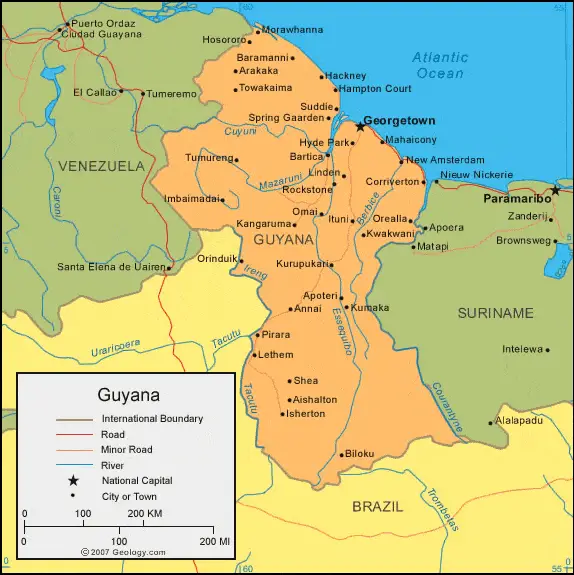
Index to the Contents
- Take Me to the Recipes
- More Articles
- 10 Fascinating Facts about Guyana
- Guyanan History and the Effect It Has Had on the Cuisine
- How Guyana’s Climate and Geography Have Influenced Guyanan Cuisine
- Understanding the Essence of Guyanan Cuisine
- Guyanan Culinary Traditions
- Exploring Guyana’s Ingredients: The Flavors of Guyanan Cuisine
- Mastering Guyanan Cuisine Cooking Techniques
- Traditional Examples of Guyanan Food
- Exploring Guyanan Street Food
- The Most Popular Guyanan Recipes
- What are the Health Implications of Guyanan Cuisine?
- Guyana’s National Dish
- Classic Guyanan Recipes to Try at Home
- Conclusion
- FAQ’s
You may also Enjoy the Following Articles
- North and South American Cuisine – A Culinary Expedition
- Europe Cuisine: Savor the Continent’s Best Culinary Secrets!
- African Cuisine: Discover the Bold Flavors & Global Charm!
- Asian Cuisine Unlock its Secrets – Taste, Health & Global Influence!
- Oceania Cooking: A Culinary Journey Through the Pacific
Savor iconic Guyanan Food Recipes – Click on each tantalizing picture to open up the Recipe.
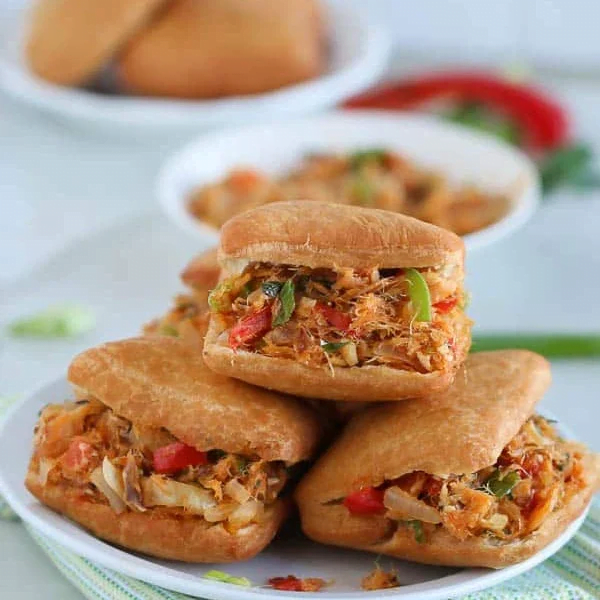


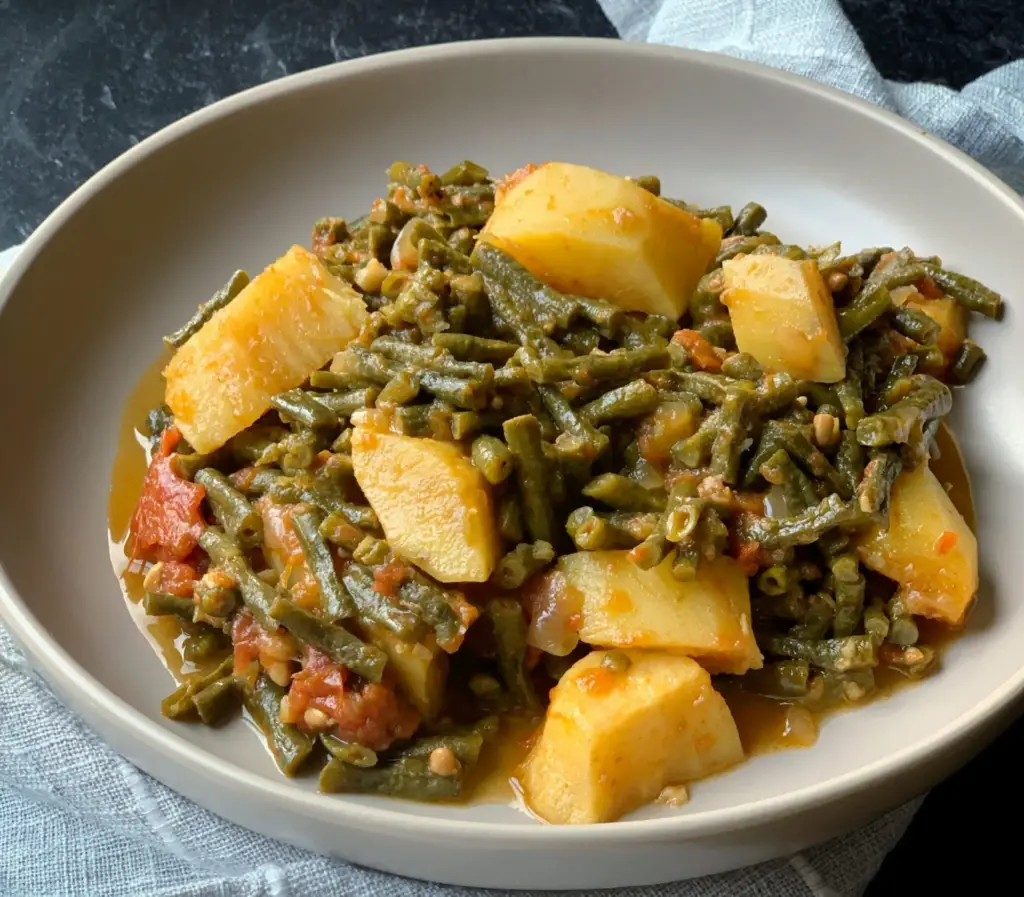
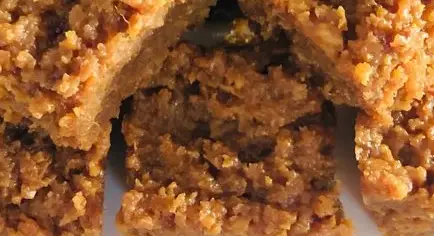
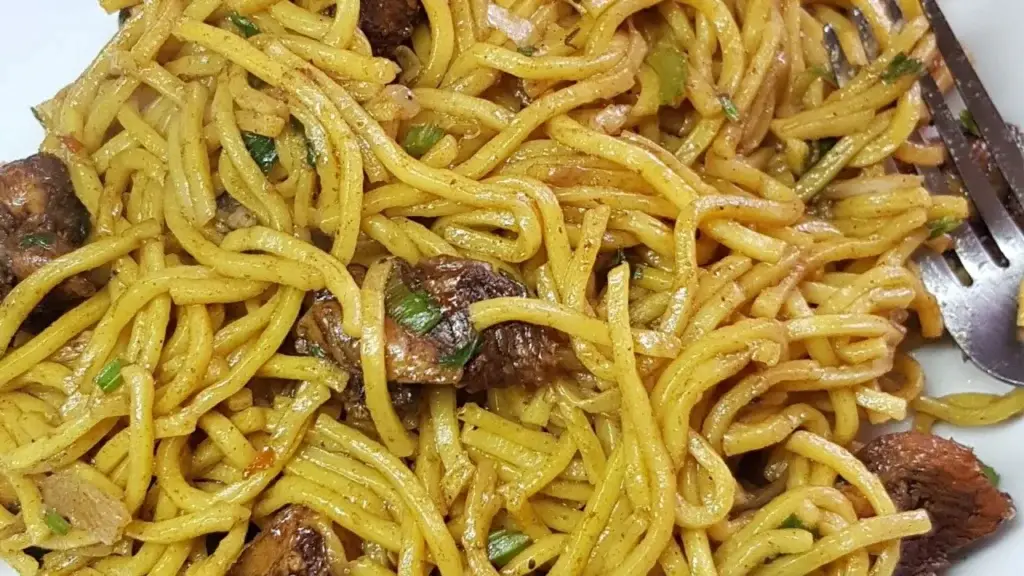
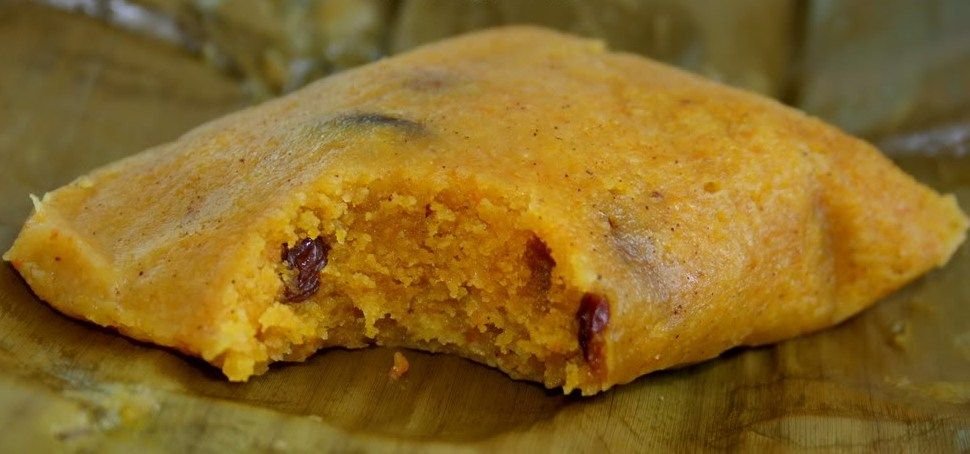
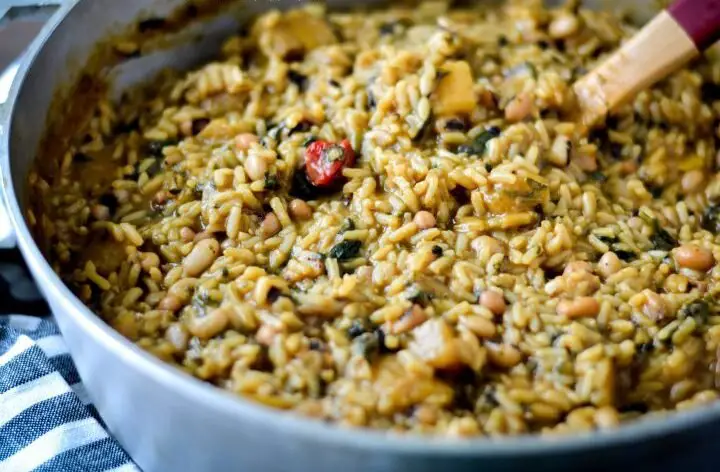

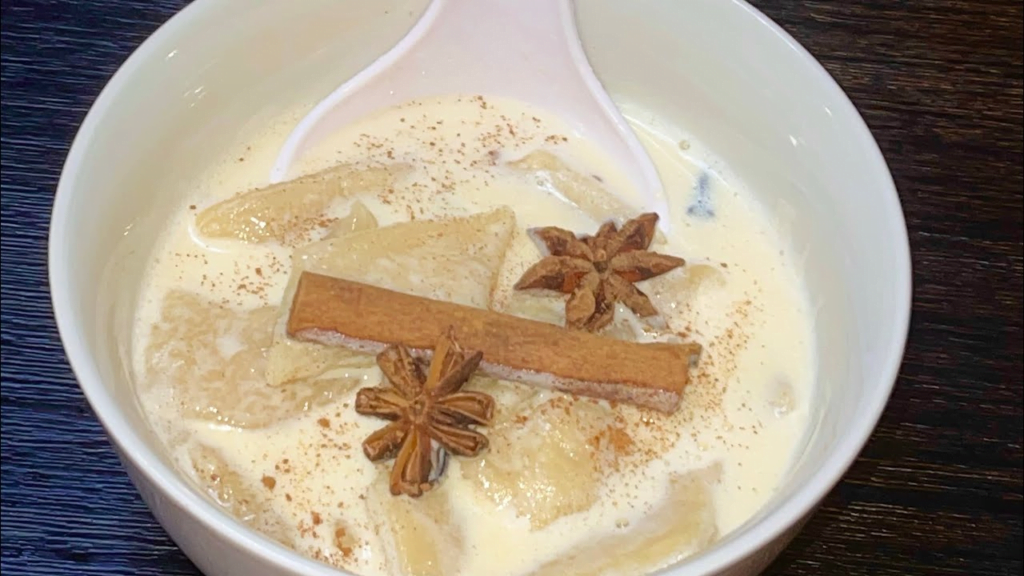

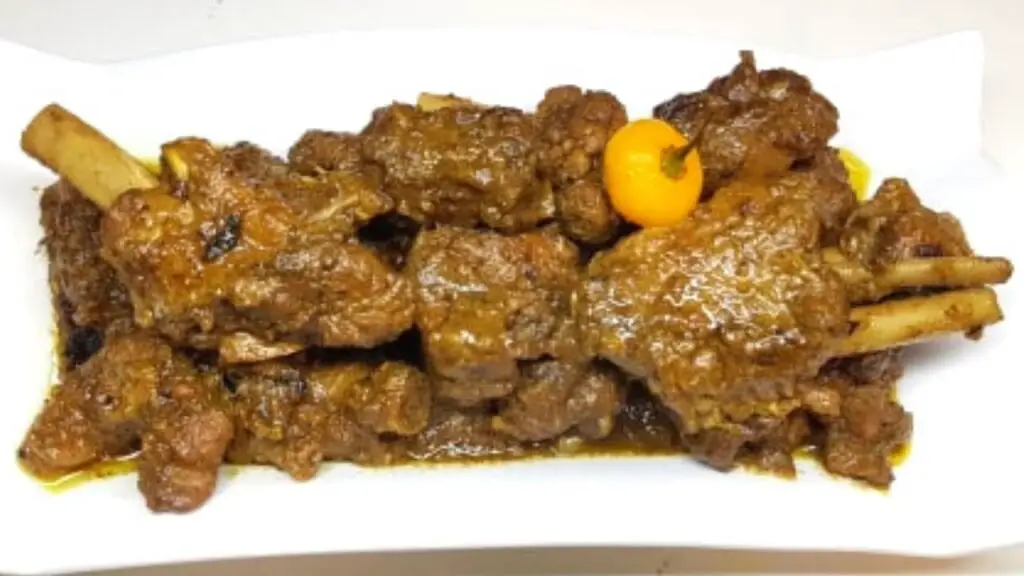
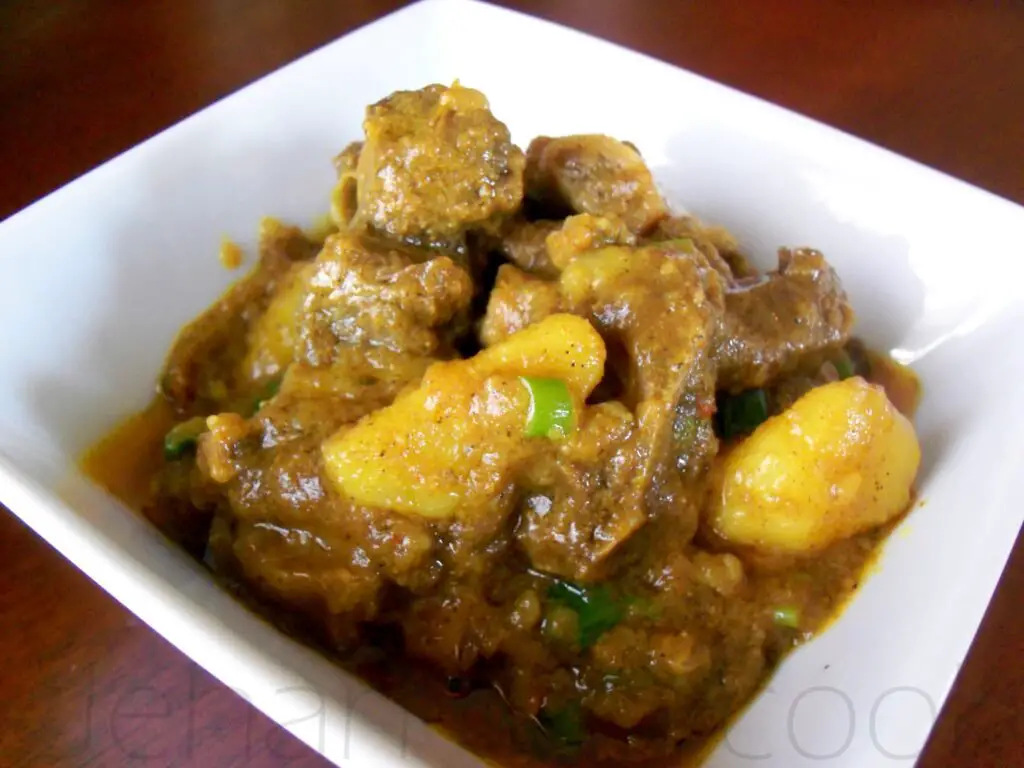
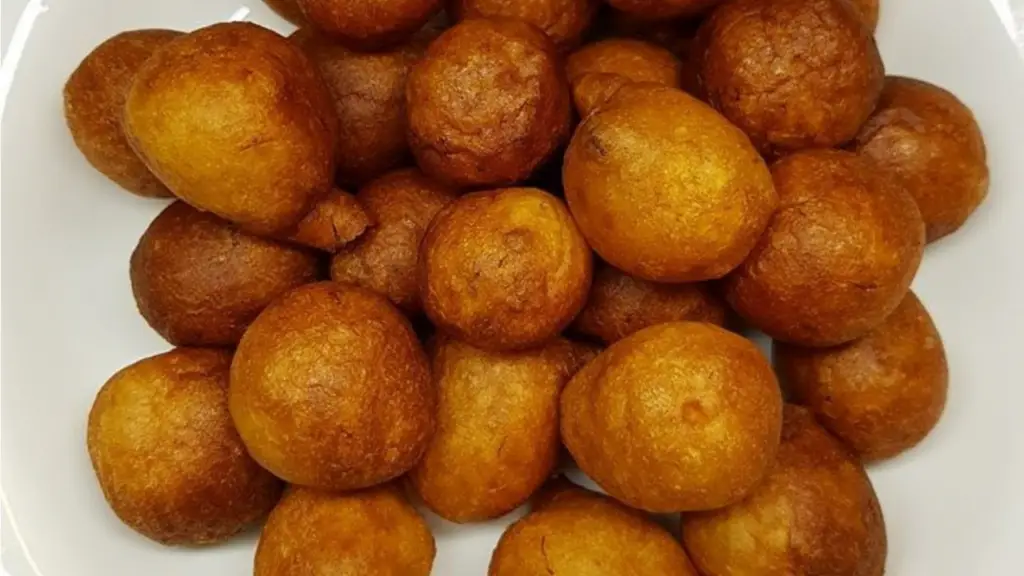
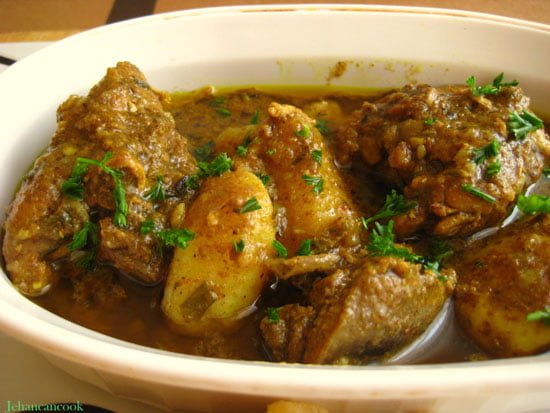
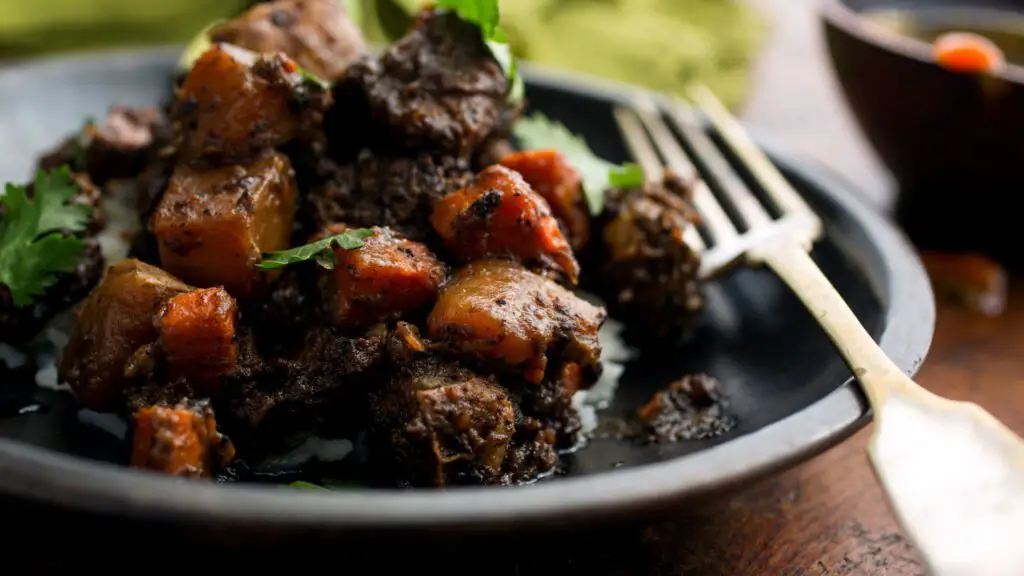
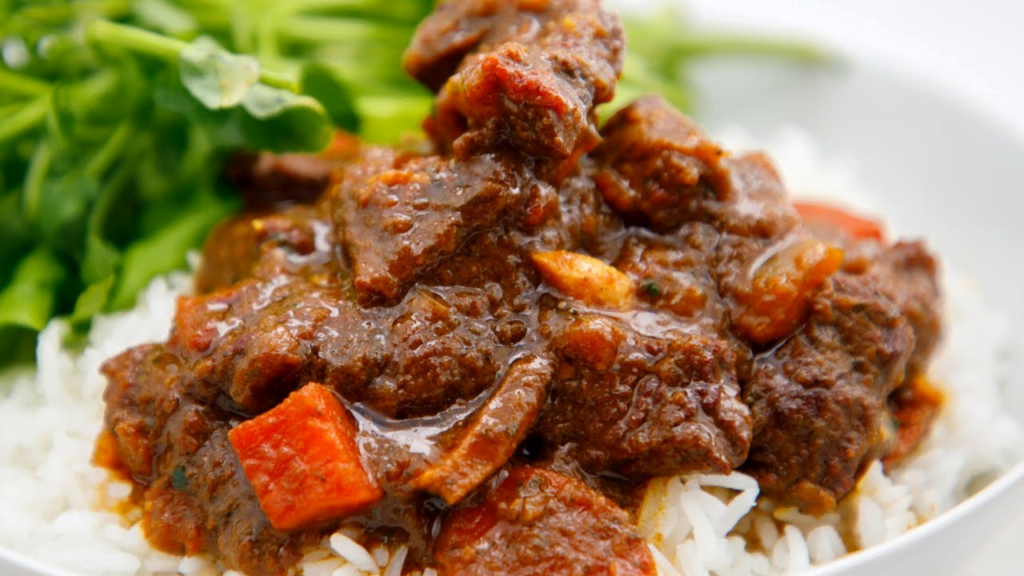
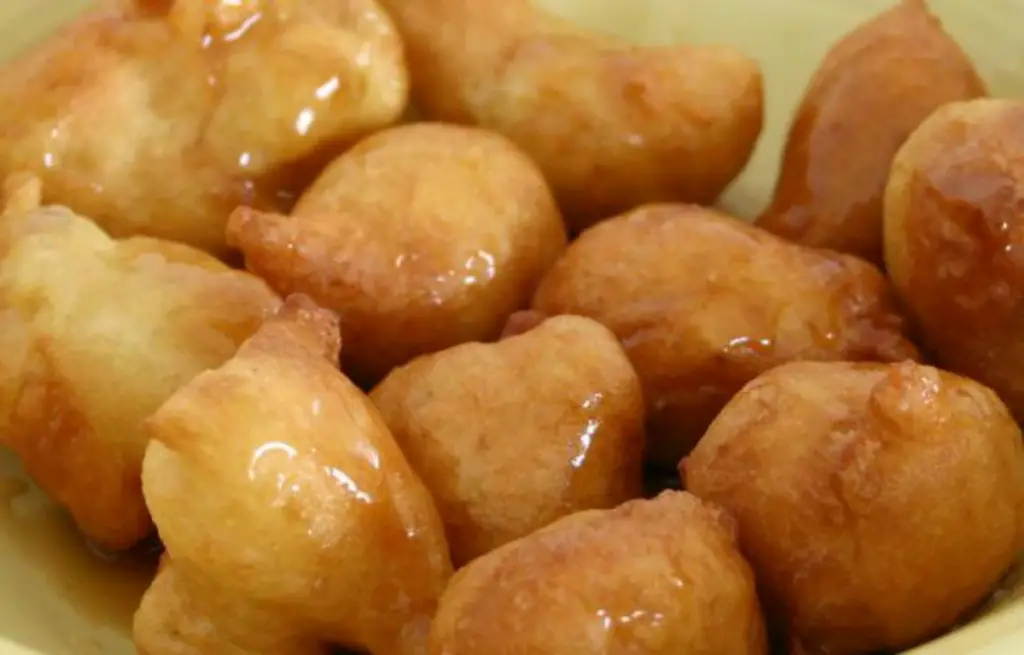

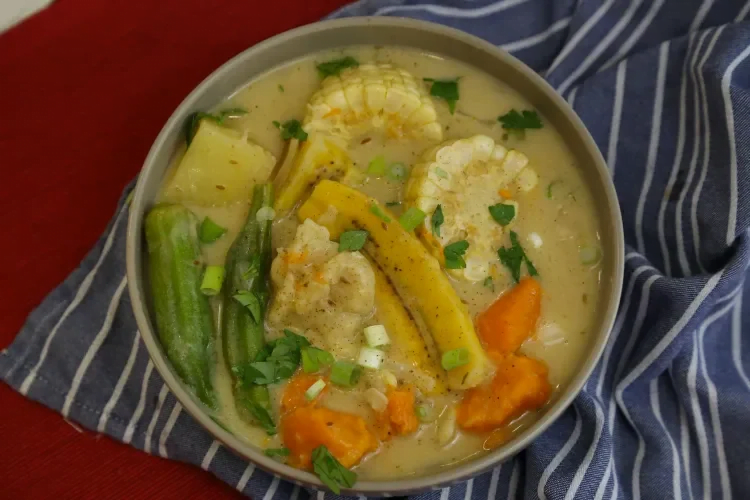

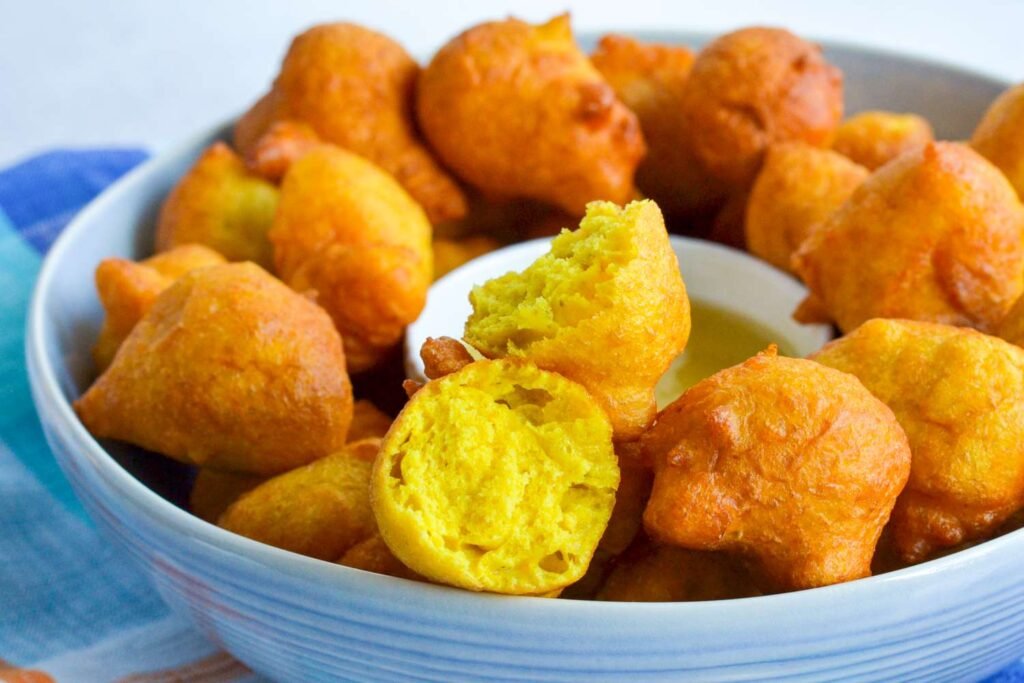
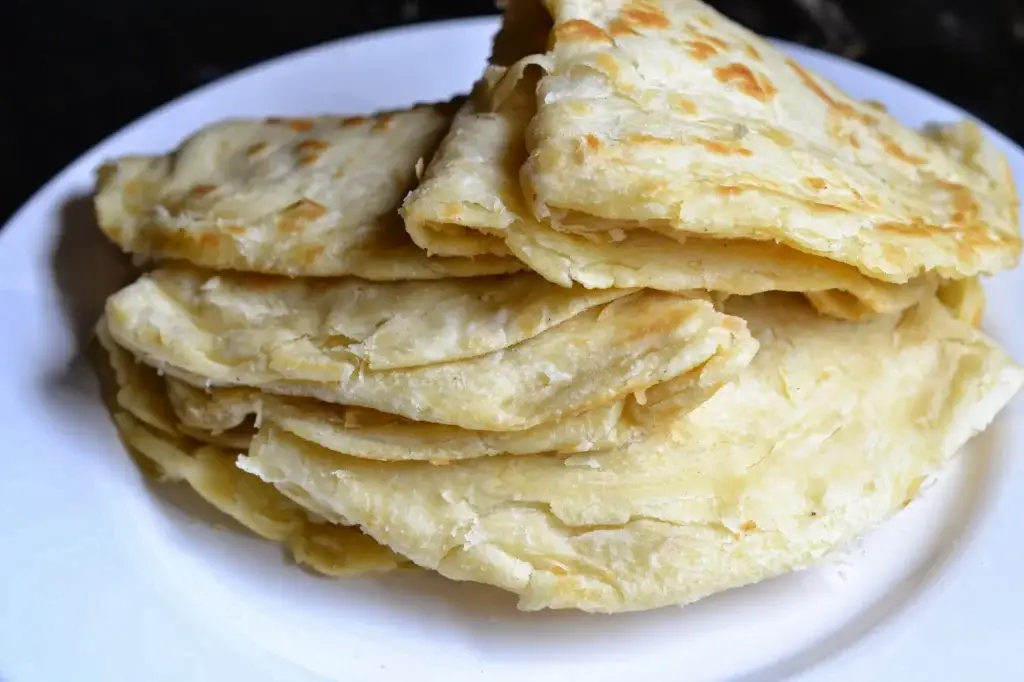
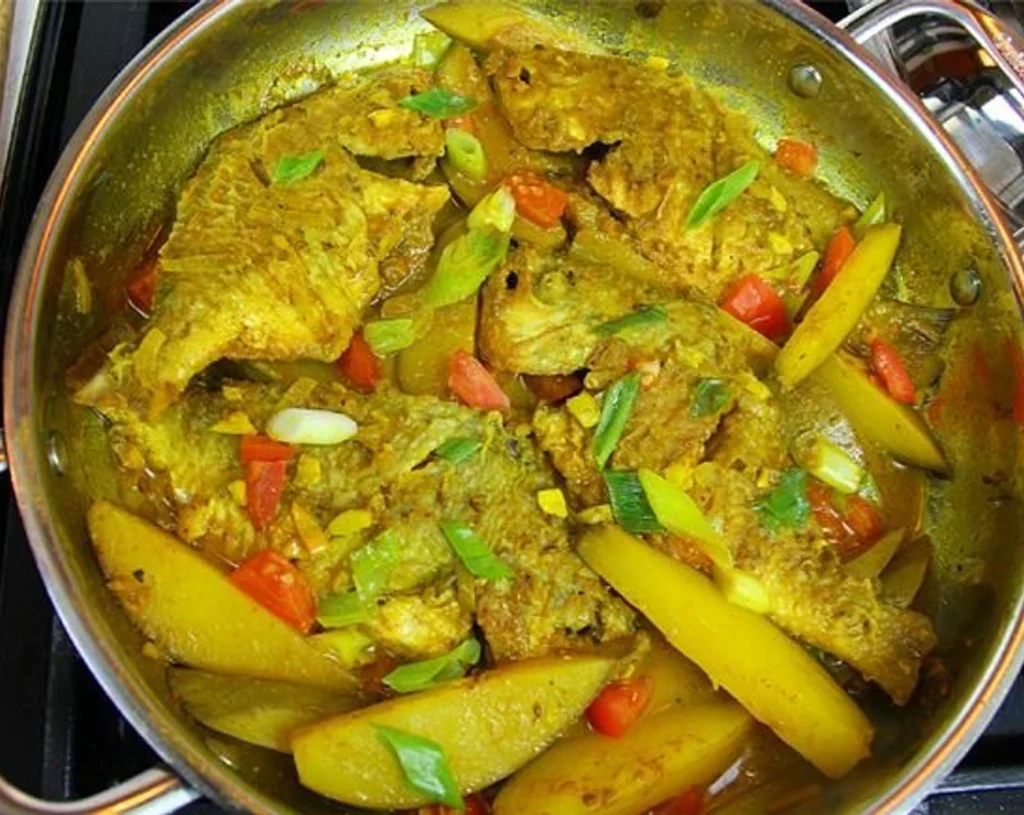
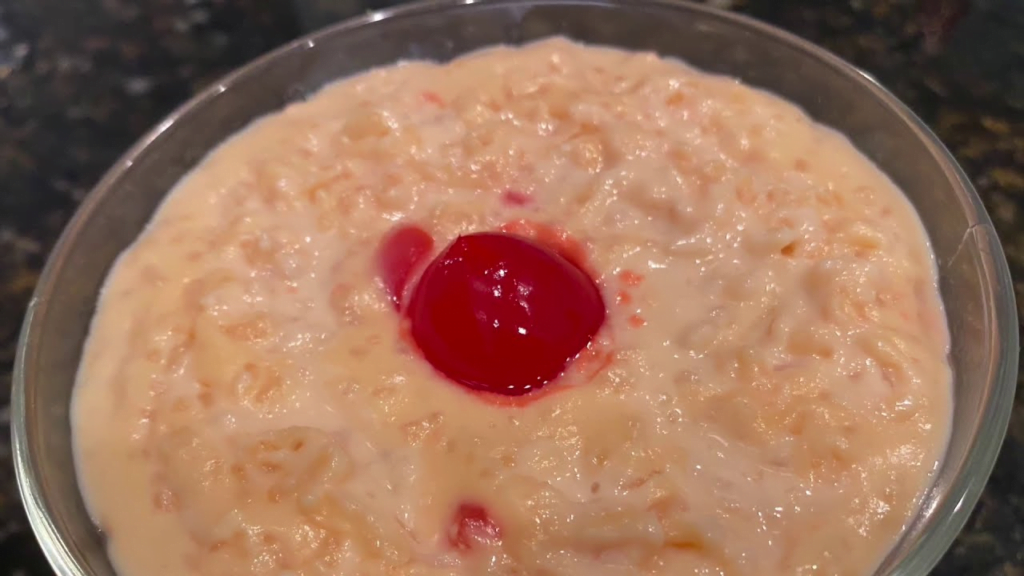
10 Fascinating Facts about Guyana

Guyana, often overshadowed by its larger South American neighbors, holds a treasure trove of unique experiences and surprising facts.
From its diverse wildlife to its historical oddities, here are 10 fascinating tidbits that will pique your interest and make you want to learn more about this hidden gem:
The Cooperative Republic
Guyana is the only country in South America with English as its official language, a legacy of its British colonial past. This unique characteristic sets it apart and makes it an attractive destination for English-speaking travelers.
A Land of Giants

Kaieteur Falls, located in the heart of Guyana’s rainforest, is not the widest waterfall in the world, but it boasts the distinction of being the world’s single largest drop of water by volume. Witnessing this cascading behemoth plummeting 741 feet into a deep gorge is a breathtaking experience.
The Capybara Capital
If you’re looking for the world’s largest rodent, look no further than Guyana. These adorable capybaras, resembling giant guinea pigs, roam freely in the lush grasslands and contribute to the vibrant biodiversity of the country.
Home to a Poisonous Bird

The Hoatzin, a peculiar bird native to Guyana, is known for its prehistoric appearance and its unusual diet. It feeds on leaves and has a fermentation process in its crop similar to a cow, allowing it to digest tough vegetation.
A Melting Pot of Cultures
Guyana boasts a rich tapestry of ethnicities, shaped by its colonial past and subsequent waves of immigration. This diversity is reflected in its vibrant cultural scene, evident in its music, cuisine, and festivals.
The Golden Land
Guyana’s name originates from an indigenous term meaning “Land of Many Waters.” This aptly describes the country’s abundance of rivers, waterfalls, and rainforests, making it a haven for nature lovers and adventure seekers.
The Cricket Crazy Nation

Cricket is more than just a sport in Guyana; it’s a national obsession. The country has produced several world-renowned cricketers and boasts a passionate fan base that eagerly follows the sport.
The Arrowpoint People
Guyana’s indigenous population, comprising nine distinct tribes, has a rich cultural heritage dating back thousands of years. Their traditional skills, such as basket weaving and wood carving, are still practiced today and offer a glimpse into their unique way of life.
Space Exploration Aspirations

In 1970, Guyana became the first developing country to launch a satellite into space in collaboration with the Soviet Union. This historic event showcases the country’s progressive spirit and its commitment to scientific advancement.
The Giant Lily Pad

Guyana is home to the Victoria Regia, the largest water lily in the world. These magnificent plants boast leaves that can reach up to 10 feet in diameter and can support the weight of a small child!
These are just a few of the many fascinating facts that make Guyana a truly unique and captivating destination. So, pack your bags, unleash your curiosity, and discover the hidden wonders of this South American gem!
Guyanan History and the Effect It Has Had on the Cuisine

Guyana’s story unfolds like a well-worn map, each wrinkle etched by time and the movement of people. Today, we embark on a delicious journey, tracing the footsteps of civilizations and their lasting impact on Guyana’s vibrant cuisine.
The First Bites: Indigenous Roots (35,000 Years Ago)
Our journey begins over 35,000 years ago when the first humans, ancestors of the Carib and Arawak tribes, arrived from Eurasia. Their culinary practices were deeply rooted in the land, with hunting, gathering, and using fresh, local ingredients forming the foundation of their meals.
A Land of Many Waters: The Arawak and Carib Legacy (Pre-Columbian)

By the time Christopher Columbus set sail, Guyana was inhabited by two distinct groups: the Arawaks along the coast and the Carib people in the interior.
Their legacy lives on not just in their descendants but also in the very name “Guyana,” which encompasses modern Guyana, Suriname, and French Guiana, aptly meaning “land of many waters.”
Colonial Era: A New Chapter (16th-19th Century)
European arrival, starting with the Dutch, French, and then the British, left an undeniable mark on Guyana’s governance and culture. Plantation agriculture became the economic engine, initially fueled by the barbaric practice of slavery. However, this dark period wasn’t without resistance.
Major slave rebellions in 1763 and 1823 not only shaped the course of history but also influenced the evolving culinary landscape.
From Slavery to Indentured Labor (1833 Onwards)

Following the abolishment of slavery in 1833, the freed African population left a void in the plantation system. To fill this gap, indentured laborers, primarily from India, were brought to Guyana.
This influx intertwined Indian culinary traditions with the existing Afro-Guyanese cuisine, creating a fusion of flavors that continues to this day.
Independence and Beyond: A Nation Evolves (1966 – Present)
Guyana gained its independence from Britain on May 26, 1966, ushering in a new era of political and cultural change.
Leaders like Forbes Burnham and Desmond Hoyte, along with events like the Jonestown tragedy, shaped the nation’s trajectory, impacting the food system as well.

A Melting Pot of Flavors: Guyana’s Culinary Tapestry
Today, Guyana’s cuisine is a testament to its rich multicultural heritage. Influences from Africa, India, Europe, and the indigenous population have come together to create a unique and flavorful blend.
Dishes like roti, curry, pepperpot, and metemgee are just a few examples of this culinary fusion.
Beyond Sustenance: A Story on a Plate
Guyanese cuisine transcends mere sustenance; it’s a narrative woven with threads of survival, adaptation, and a shared history. Each dish whispers tales of the past, honoring the struggles and triumphs of the people who have shaped this incredible nation.
So, the next time you savor a Guyanese dish, remember the journey it represents, a journey reflected in every delicious bite.
References
How Guyana’s Climate and Geography Have Influenced Guyanan Cuisine

Guyana, nestled on the northern coast of South America, is a land where culinary magic unfolds—a symphony of flavors shaped by its geography, climate, and diverse heritage. Let’s explore how this tropical paradise weaves its rich tapestry of cuisine.
The Influence of Geography
Terroir: The Soul of Guyanese Food
- Terroir—a French concept—defines Guyana’s culinary identity.
- Each region boasts its unique terroir, influencing ingredients, cooking techniques, and family recipes.
The Coastal Bounty
- Along the Atlantic coast, seafood reigns supreme. Think pepperpot—a slow-cooked meat stew infused with cassareep (a bitter-sweet sauce made from cassava).
- The fertile coastal soil yields rice, plantains, and coconut—staples in Guyanese kitchens.
Climate and Ingredients

Tropical Abundance
- Guyana’s equatorial climate blesses it with:
- Exotic Fruits: Mangoes, pineapples, and passion fruit burst with flavor.
- Spices: Turmeric, ginger, and fiery peppers add depth to dishes.
The Hinterland’s Bounty
- In the interior highlands, lush rainforests shelter indigenous communities.
- Cassava, wild game, and freshwater fish sustain these resilient people.
Regional Specialties
Georgetown: The Melting Pot
- The capital city blends influences from Africa, India, Europe, and the Caribbean.
- Roti, curry, and metemgee (a hearty breakfast dish) grace Georgetown’s tables.
Essequibo Coast: Rice and Spice
- The fertile Essequibo River delta produces aromatic rice.
- Pepperpot and bake (fried bread) are staples here.
Berbice: A Taste of History
- Berbice’s colonial past echoes in its cuisine.
- Fried fish, cassava bread, and black pudding tell tales of Dutch and British settlers.
Food as Heritage
Indigenous Wisdom
- Amerindian communities honor their ancestors through farine (cassava bread) and piwari (fermented cassava drink).
- These traditions connect them to the land.
Indian Influence
- Indian indentured laborers brought curry, roti, and dhal (lentil stew).
- These dishes are now Guyanese classics.
References
Understanding the Essence of Guyanan Cuisine
Traditional Guyanese cuisine offers an incredible array of flavors, reflecting the country’s multicultural heritage and history. The dishes are a reflection of the various cultures that have influenced Guyana over the centuries, such as African, Indian, Chinese, and Indigenous traditions.
To truly appreciate the essence of Guyanese cuisine, it’s important to understand the cultural significance behind each dish.

Food plays an important role in many Guyanese celebrations and gatherings. For example, pepperpot, a rich and spicy stew of Amerindian origin, is often served during Christmas and New Year’s celebrations. Another popular dish is curry, a staple in Indian and Caribbean cuisine, which has been adapted with local ingredients to create a unique Guyanese flavor profile.
Seafood also features prominently in Guyanese cuisine, including fish like snapper and tilapia, as well as shellfish like crab and shrimp. We season these ingredients with fragrant herbs and spices, such as garlic, thyme, and coriander, to create dishes that are as flavorful as they are satisfying.
Overall, traditional Guyanese cuisine is a reflection of the country’s rich cultural heritage, and offers a tantalizing journey for the senses. Whether you’re a food enthusiast or simply looking to broaden your culinary horizons, exploring the delicious dishes of Guyanese cuisine is a journey you won’t want to miss.
Guyanan Culinary Traditions
When it comes to Guyanese cuisine, the flavors, aromas, and textures are truly unforgettable. The combination of African, Indian, Chinese, and Indigenous traditions creates a fusion of tastes that is unique to this South American country.
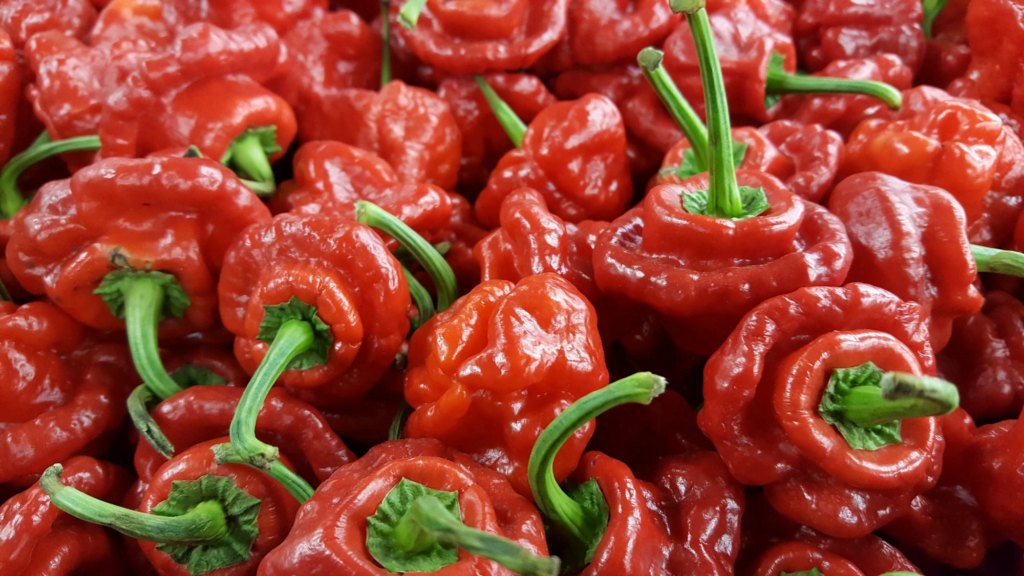
One of the most striking aspects of Guyanese cuisine is the use of spices and herbs to add depth and complexity to dishes. From fiery scotch bonnet peppers to aromatic cumin and coriander, each spice plays a crucial role in creating the distinct flavors that define Guyanese cuisine.
Another defining characteristic of Guyanese cuisine is the use of fresh, locally sourced ingredients. From the fruits and vegetables grown in the country’s lush rainforests to the seafood caught off its shores, each ingredient is carefully selected to ensure the best possible flavor and quality.
Guyanese cuisine is deeply rooted in the country’s rich cultural heritage, reflecting the history and traditions of the Guyanese people. From festive celebrations to everyday meals, Guyanese culinary traditions are an integral part of the country’s identity.
Whether you’re savoring a hearty bowl of pepperpot – a stew made with meat, cassava, and spices – or indulging in a sweet and flaky piece of pine tart, every bite of Guyanese cuisine is a journey for the senses.
So why not bring the unforgettable flavors of Guyanese cuisine into your own kitchen? With a variety of authentic Guyanese recipes available, you can experience the magic of Guyanese flavors in your own home.
At its core, Guyanese cuisine is a celebration of the country’s diverse cultural heritage and natural bounty. It’s an experience that is truly unique and one that we can’t wait for you to try.
Exploring Guyana’s Ingredients: The Flavors of Guyanan Cuisine

Guyanese cuisine, a vibrant tapestry woven from diverse influences, boasts a unique array of ingredients that tantalize the taste buds and tell stories of cultural heritage. From the fertile soil to the bountiful waters, Guyana’s pantry is a treasure trove waiting to be explored.
The Humble Staples
- Cassava: This starchy root vegetable forms the foundation of many Guyanese dishes. It’s boiled, fried, grated, and roasted, offering versatility and sustenance. Dishes like cassava bread and farine (roasted cassava flour) are staples on Guyanese tables.
- Plantains: These versatile green bananas are cooked in various ways, from sweet fried plantain chips to savory boiled plantains served with stews. They add a unique sweetness and texture to the cuisine.
- Rice: A legacy of Indian influence, rice is a popular accompaniment to curries, stews, and stir-fries. Basmati and parboiled rice varieties are commonly used.
The Flavorful Trio
- Coconut: This tropical fruit adds a touch of sweetness, creaminess, and richness to numerous dishes. Coconut milk is used in curries, soups, and stews, while grated coconut adds texture to cakes and desserts. Coconut water is a refreshing beverage enjoyed throughout the day.
- Peppers: Guyanese cuisine embraces a range of peppers, from the fiery habanero to the milder scotch bonnet. These peppers add a distinct kick, heat, and depth of flavor to dishes like pepperpot, a national treasure.
- Spices: Guyanese cuisine boasts a vibrant medley of spices, including turmeric, cumin, coriander, clove, and nutmeg. These spices infuse dishes with warmth, complexity, and an aromatic depth that defines the Guyanese flavor profile.
From Land and Sea
- Freshwater Fish: Guyana’s rivers and coastal waters are home to a variety of fish, including catfish, tilapia, and the iconic arapaima, the world’s largest freshwater scaled fish. These are often cooked in stews, curries, and stewed with coconut milk.
- Meat: Chicken, beef, and pork are commonly used in Guyanese cuisine, often cooked in stews, curries, and barbeque. Local favorites include “cook-up rice,” a hearty rice dish with meat and vegetables, and “pepperpot,” featuring a variety of meats simmered in a spicy and flavorful broth.
- Vegetables: Guyanese cuisine utilizes a variety of vegetables, including leafy greens like callaloo, eddoes (similar to taro root), ochro (okra), and pumpkin. These add vibrant colors, textures, and essential nutrients to the diet.
Beyond Ingredients: A Culinary Fusion
These ingredients are not merely components; they are the storytellers of Guyana’s rich history. They speak of African influences in the use of plantains and okra, Indian influences in the use of spices and rice, and indigenous influences in the utilization of cassava and local vegetables.
So, the next time you encounter a Guyanese dish, take a moment to appreciate the unique ingredients, each playing a vital role in creating a symphony of flavors that reflects the cultural tapestry of this vibrant nation. Bon appétit!
Mastering Guyanan Cuisine Cooking Techniques

Guyanese cuisine, a vibrant blend of African, Indian, European, and Indigenous influences, offers a unique and flavorful culinary experience. But mastering these dishes goes beyond just having the right ingredients.
Understanding the essential cooking techniques is key to unlocking the true essence of Guyanese food. So, grab your apron and prepare to embark on a culinary adventure as we explore the heart and soul of Guyanese cooking methods:
The Art of Simmering
- Low and slow: Simmering is a fundamental technique in Guyanese cuisine. Dishes like pepperpot, stews, and curries are cooked over low heat for extended periods, allowing flavors to develop deeply and meld together seamlessly.
- This results in incredibly flavorful and tender meats, vegetables, and rich sauces.
The Power of Roasting
- Unlocking sweetness and depth: Roasting plays a crucial role in Guyanese cooking, adding a smoky and caramelized depth of flavor. From roasting plantains and cassava for a unique sweetness to charring spices for aromatic curries, this technique unlocks hidden dimensions of flavor in various dishes.
The Magic of Frying
- Crispy delights: Frying isn’t just about deep-frying; it encompasses various methods in Guyanese cuisine. From shallow-frying fish and pakoras (fritters) to stir-frying vegetables in stews, this technique adds a delightful textural contrast and enhances the inherent flavors of the ingredients.
The Versatility of Boiling
- From base to flavor: Boiling is a versatile technique used for various purposes. It forms the base for soups and stews, parboils rice to enhance texture, and cooks some vegetables to retain their vibrant colors and nutrients.
The Touch of Curry Making
- A symphony of spices: While diverse curries exist in Guyanese cuisine, the general technique involves tempering spices in hot oil. This releases their aromatic oils, infusing the base (often onions, garlic, and ginger) with an intense fragrance and forming the flavor foundation for the curry.
The Unique “Cooking Up”
- One-pot wonder: “Cooking up” is a beloved technique in Guyana, where various ingredients like rice, meat, vegetables, and spices are combined in a single pot and cooked together. This allows the flavors to intermingle, creating a harmonious and satisfying dish.
Beyond Technique: Embracing the Spirit
Mastering Guyanese cooking techniques is just the beginning. It’s also about understanding the cultural context and the spirit of the cuisine. Guyanese food is not just about elaborate dishes; it’s about slow cooking, patience, and a love for sharing.
So, gather your loved ones, experiment with these techniques, and let the vibrant flavors of Guyana fill your kitchen and your heart.
Traditional Examples of Guyanan Food
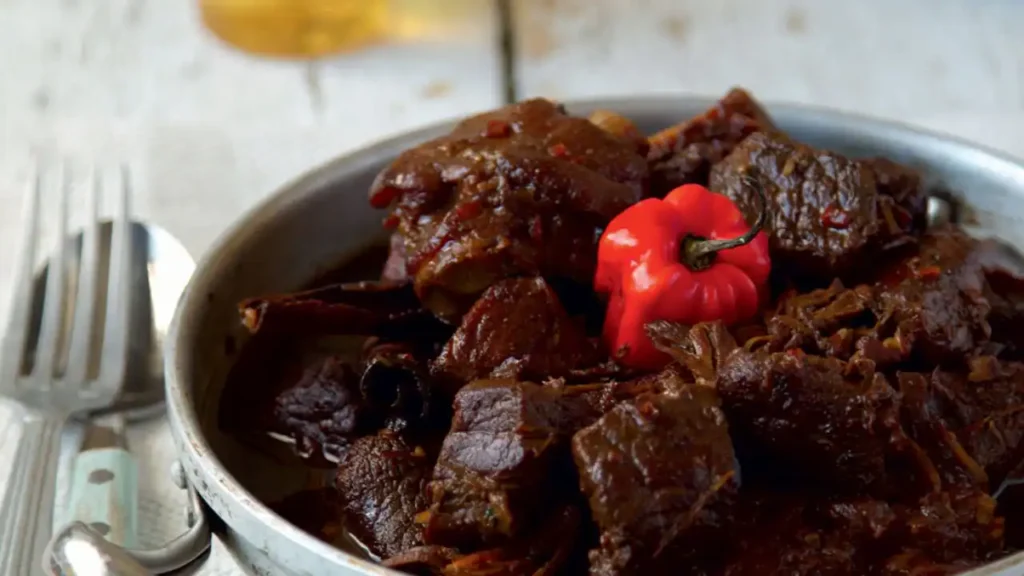
Guyana, a vibrant South American nation, boasts a culinary tapestry woven from diverse influences. Its cuisine, a delightful fusion of African, Indian, European, and Indigenous traditions, offers a unique and flavorful experience.
Today, we embark on a delicious journey, exploring five iconic Guyanese dishes that capture the very essence of this remarkable cuisine:
Pepperpot: A Savory Stew Steeped in History
Considered Guyana’s national dish, pepperpot is a slow-cooked stew simmered to perfection. Traditionally featuring meat like beef, lamb, or pork, it is uniquely flavored with cassareep, a rich sauce derived from cassava root and flavored with spices.
The long simmering time allows the flavors to meld, creating a complex and savory dish that embodies the spirit of slow cooking and patience, deeply ingrained in Guyanese culture.
Cook-Up Rice: A One-Pot Symphony of Flavor
This beloved dish is a testament to Guyana’s diverse influences. Combining rice, meat (often chicken, beef, or seafood), vegetables like peas and carrots, and a vibrant blend of spices, cook-up rice is a one-pot wonder.
Each ingredient contributes to a symphony of textures and aromas, making it a hearty and satisfying meal that is perfect for any occasion.
Roti: A Versatile Flatbread Packed with Flavor
Roti, a flatbread originating from India, has become an essential element in Guyanese cuisine. Traditionally made with flour and water, it is cooked on a griddle until slightly browned and puffy.
Roti serves as a versatile canvas, enjoyed plain, filled with curried vegetables or meat, or even wrapped around various savory fillings. Its versatility and affordability make it a staple enjoyed across Guyana.
Metemgee: A Comforting Coconut Milk Stew
This comforting stew, often enjoyed for breakfast or as a light lunch, features a creamy coconut milk base and a variety of ingredients like plantains, eddoes (similar to taro root), pumpkin, and sometimes seafood or meat.
The subtle sweetness of the coconut milk paired with the savory notes from the other ingredients creates a warm and comforting dish that is both delicious and nourishing.
Curry: A Celebration of Spices and Aromatics
Guyanese curries, influenced by Indian traditions, are a vibrant celebration of spices and aromatics. While variations exist, the general technique involves tempering spices in hot oil, building a flavorful base, and adding meat, vegetables, and coconut milk.
From the fiery chicken curry to the vegetarian pumpkin curry, each variation offers a unique explosion of flavors that tantalize the taste buds.
These five dishes are just a glimpse into the diverse and flavorful world of Guyanese cuisine. Each bite is a journey through history, culture, and tradition, offering a taste of the very essence of Guyana.
So, the next time you have the opportunity, embark on your own culinary adventure and explore the vibrant flavors of this remarkable nation.
Exploring Guyanan Street Food

Venture beyond the restaurants and delve into the vibrant world of Guyanese street food, where flavors explode on every corner and aromas entice your senses.
These mobile kitchens, often family-run and passed down through generations, offer a delicious and affordable way to experience the heart of Guyanese cuisine.
Flavorful Gems from the Streets
- Doubles: This iconic street food starts with golden bara, a deep-fried flatbread made from split peas flour. It’s then split and filled with a flavorful combination of curried chickpeas (chana), fried plantains, and a dash of pepper sauce for a delightful explosion of textures and tastes.
- Saltfish and Bake: This simple yet satisfying dish features fluffy, golden bake (fried dough) served alongside crispy fried saltfish. The combination of the salty fish and the soft, pillowy bake creates a delightful contrast in textures and flavors, making it a popular breakfast or snack option.
- Coconut Water: Escape the heat and quench your thirst with fresh coconut water, nature’s refreshing beverage. Vendors skillfully chop off the top of young coconuts, offering you a straw to sip this naturally hydrating, electrolyte-rich drink.
- Guyanese Roti: This versatile flatbread takes center stage on the streets as well. Filled with various curries, vegetables, or meats, it’s a portable and flavorful meal on the go. Vendors often offer vegetarian options like pumpkin curry or egg curry alongside traditional chicken or lamb curries.
- Sugarcane Juice: This refreshing drink is a local favorite, made by crushing fresh sugarcane and extracting its sweet juice. The vibrant green juice is a natural source of energy and a healthy alternative to sugary beverages, perfect for a hot Guyanese day.
Vibrant Cities for Street Food Adventures
While the entire country offers a taste of street food delights, some cities boast a particularly vibrant street food scene:
- Georgetown: The capital city is a haven for street food enthusiasts, with vendors lining the streets and bustling market squares like Stabroek Market and Bourda Market offering a diverse range of options.
- Linden: This second-largest city is known for its “Bar-B-Que Alley,” where vendors specialize in grilled meats, like barbeque chicken and pork, alongside other street food favorites.
- New Amsterdam: Located in the eastern part of the country, New Amsterdam has a distinct Dutch influence reflected in its street food scene, offering unique delicacies like “pastels” (deep-fried dough pockets filled with savory or sweet fillings).
Beyond the Bites: A Cultural Experience
Guyanese street food is more than just a culinary experience; it’s a window into the soul of the nation. It’s about community, affordability, and sharing cultural heritage through food.
So, next time you’re in Guyana, grab a napkin, embrace the vibrant street food scene, and savor the delicious stories embedded in every bite. Bon appétit!
The Most Popular Guyanan Recipes
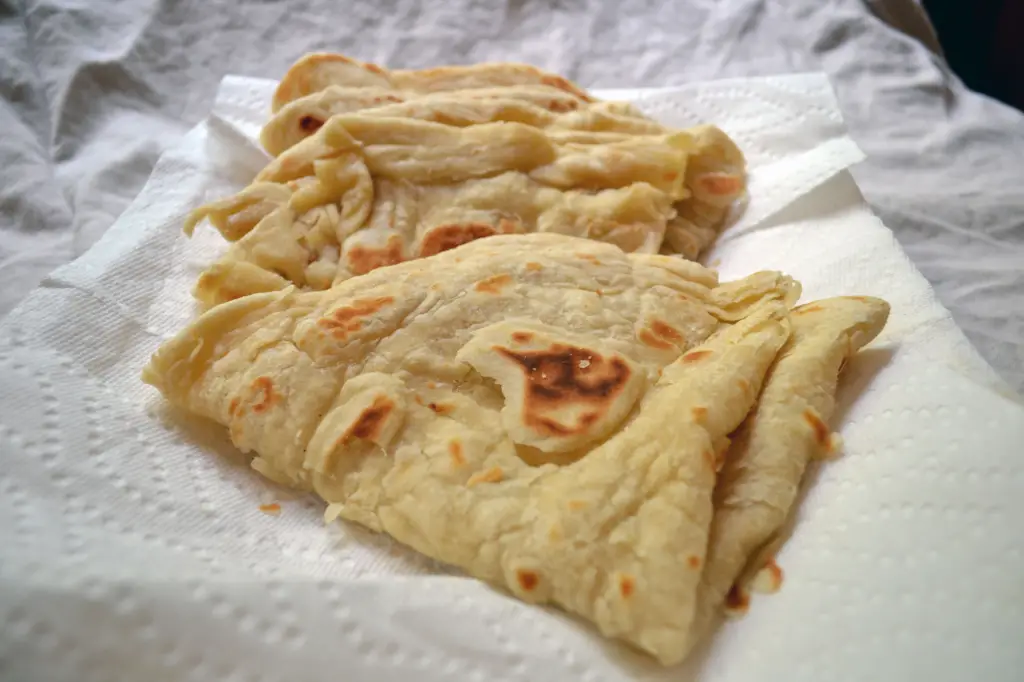
Guyanese cuisine, a vibrant tapestry woven from African, Indian, European, and Indigenous influences, offers a unique and flavorful adventure for food enthusiasts. From hearty stews to savory snacks, here are 10 of the most popular Guyanese recipes that will tantalize your taste buds:
Pepperpot
Guyana’s national dish, this slow-cooked stew features meat (beef, lamb, or pork) simmered in a rich “cassareep” sauce (made from cassava root) and flavored with spices.
Cook-Up Rice
A one-pot wonder, cook-up rice combines rice, meat (chicken, beef, or seafood), vegetables, and spices for a hearty and satisfying meal.
Roti
This versatile flatbread comes plain or filled with curried vegetables, chicken, or other savory fillings, making it a delicious and portable option.
Metemgee
This comforting stew features a creamy coconut milk base with an array of ingredients like plantains, eddoes (similar to taro root), pumpkin, and sometimes seafood or meat.
Curry
A celebration of spices and aromatics, Guyanese curries come in various forms, often featuring chicken, vegetables, or seafood simmered in a flavorful coconut milk base.
Doubles
This iconic street food features golden bara (deep-fried flatbread) filled with curried chickpeas, fried plantains, and a touch of pepper sauce for a delightful combination of textures and flavors.
Saltfish and Bake
A simple yet satisfying breakfast or snack, this dish combines crispy fried saltfish with fluffy, golden bake (fried dough).
Pholourie
These deep-fried spheres made from split pea flour are a popular Guyanese snack, often enjoyed with chutney or pepper sauce.
Coconut Water
A refreshing and naturally hydrating beverage, coconut water is a popular choice to beat the heat and replenish electrolytes.
Sugarcane Juice
Extracted from fresh sugarcane, this vibrant green juice is a delicious and healthy alternative to sugary drinks, offering a natural energy boost.
This list is just a glimpse into the diverse and flavorful world of Guyanese cuisine. Each dish offers a unique taste of the country’s rich heritage and cultural influences. So, the next time you’re looking for a culinary adventure, explore the vibrant flavors of Guyana and discover your own favorite dish!
What are the Health Implications of Guyanan Cuisine?

Guyana, a nation adorned with lush rainforests, fertile soil, and a vibrant culture, boasts a cuisine that tells a captivating story of resilience and indulgence. Today, we embark on a delicious expedition, exploring the health and cultural nuances woven into every dish.
A Tropical Bounty
Guyana’s equatorial embrace grants it an exotic cornucopia of ingredients:
- Fruits: Imagine biting into juicy mangoes, sun-kissed pineapples, and passion fruit bursting with flavor and essential vitamins.
- Spices: Aromatic turmeric, ginger, and fiery peppers add depth and complexity to Guyanese dishes.
Staples for Sustenance
- Rice: The fertile Essequibo River delta nourishes Guyana with fragrant rice, a cornerstone of every Guyanese kitchen.
- Cassava: This versatile root vegetable provides sustenance in various forms, from farine (cassava bread) and cassava balls to sweet cassava pone, a delightful dessert.
A Culinary Tapestry
Guyanese cuisine is a vibrant tapestry, woven with threads from various cultures:
- Indian Influence: Indian indentured laborers brought their culinary heritage, introducing dishes like curries, rotis, and dhal (lentil stew) that became integral to the Guyanese food scene.
- African Roots: Echoes of African flavors resonate in hearty dishes like pepperpot (slow-cooked meat stew) and cook-up rice, offering both sustenance and cultural connection.
Balancing Indulgence and Health
Guyanese cuisine celebrates the joy of food but also emphasizes mindful eating:
- While pepperpot might be rich and flavorful, it’s typically enjoyed in smaller portions.
Challenges and Opportunities
- Food Security: Limited employment opportunities can pose challenges related to food accessibility for some citizens.
- Nutrition Education: Informative programs can empower individuals to make informed and healthy dietary choices.
Addressing Health Concerns
Like many nations, Guyana faces rising rates of diabetes and cardiovascular diseases. Here’s how we can navigate these challenges:
- Promoting Balanced Diets: Encouraging balanced diets and regular physical activity is crucial for maintaining overall well-being.
- Raising Cholesterol Awareness: Traditional dishes often utilize coconut milk and fried ingredients, which can contribute to high cholesterol. Educational programs can raise awareness about heart-healthy alternatives and cooking methods.
A Flavorful Future
As Guyana navigates its culinary journey, it strives to find a balance between tradition and health consciousness. Let’s savor the vibrant flavors, celebrate the rich heritage, and work towards a healthier future for all.
References
- Guyana’s food sector performing well amidst pandemic effects
- A Gastronomic Journey through Guyana’s Top 10 Famous Foods
- Food-based dietary guidelines – Guyana – Food and Agriculture Organization
- Guyana: Addressing dietary diseases by providing informative nutrition education
Guyana’s National Dish

Guyana, a diverse country located on the northeastern coast of South America, is known for its rich cultural heritage and vibrant culinary scene. Pepper pot is Guyana’s national dish, made popular by Amerindian peoples, and is often served at Christmas and special occasions.
Classic Guyanan Recipes to Try at Home

Whether you’re a seasoned chef or a beginner in the kitchen, our step-by-step instructions will guide you through recreating traditional Guyanese dishes with ease.
No matter what dish you choose, our Guyanese recipes are sure to impress your taste buds and transport you straight to the vibrant streets of Guyana. So what are you waiting for? Get cooking!
Pepperpot is a traditional Guyanese dish with Amerindian origins, and it’s often enjoyed during special occasions and holidays, particularly Christmas. This rich and flavorful stew features a blend of meats and spices that create a unique and delicious flavor. Here’s some background, a list of ingredients, and a comprehensive recipe for Guyanese Pepperpot:
Guyanese Food – Cook-Up Rice

Discovering Guyana’s Culinary Gem: Cook-Up Rice Extravaganza
History and Background
Guyanese cuisine is a vibrant fusion reflecting the diverse cultural influences in the region. One standout dish that encapsulates this rich tapestry is Cook-Up Rice. Originating from the Amerindian and African communities, Cook-Up Rice is a beloved staple in Guyana, celebrated for its hearty blend of rice, beans, and various meats.
This dish not only nourishes the body but also symbolizes unity and togetherness in the Guyanese culture.
Guyanese Food – Cook-Up Rice Ingredients
- 2 cups rice
- 1 cup black-eyed peas
- 1 cup coconut milk
- 1 lb meat (chicken, beef, or pork), diced
- 1 lb salted fish, soaked and flaked
- 1 large onion, chopped
- 3 cloves garlic, minced
- 1 scallion, chopped
- 1 large tomato, diced
- 1 cup okra, sliced
- 1 cup pumpkin, diced
- 1 cup spinach or callaloo, chopped
- 1 Scotch bonnet pepper, whole
- 2 tablespoons vegetable oil
- Salt and pepper to taste
Guyanese Food – Cook-Up Rice Recipe
Prepare Ingredients
- Soak Black-Eyed Peas:
- Rinse and soak the black-eyed peas overnight, then drain.
- Prepare Meat:
- Season the diced meat with salt and pepper.
Cook Rice and Beans
- Combine Rice and Coconut Milk:
- In a large pot, combine the rice and coconut milk.
- Add Black-Eyed Peas:
- Mix in the soaked black-eyed peas and bring to a simmer.
- Cook Meat:
- In a separate pan, brown the seasoned meat in vegetable oil.
- Incorporate Salted Fish:
- Add the flaked salted fish to the meat, cooking until it releases its flavors.
Assemble the Cook-Up Rice
- Combine Ingredients:
- Add the seasoned meat and salted fish to the pot of rice and beans.
- Add Vegetables:
- Stir in onion, garlic, scallion, tomato, okra, pumpkin, spinach or callaloo, and Scotch bonnet pepper.
- Simmer Until Cooked:
- Allow the ingredients to simmer until the rice is cooked, and flavors meld together.
Serve and Enjoy
- Remove Scotch Bonnet Pepper:
- Discard the whole Scotch bonnet pepper.
- Fluff Rice and Serve:
- Fluff the Cook-Up Rice with a fork and serve hot.
Serving: This recipe serves approximately 6 people.
Cooking Time: Approximately 1 hour and 30 minutes.
Nutritional Information (per serving):
- Calories: 450
- Protein: 25g
- Fat: 12g
- Carbohydrates: 60g
- Fiber: 8g
Embark on a culinary journey with Guyana’s Cook-Up Rice—an inviting dish that brings people together around the table.
Guyanese Food – Guyanese Style Chicken Curry

History and Background
Guyana, a land where diverse cultures merge, showcases a unique culinary heritage. One dish that stands out in the vibrant tapestry of Guyanese cuisine is the Guyanese Style Chicken Curry.
Influenced by Indian flavors and embraced by the entire nation, this curry is a harmonious blend of spices, tradition, and the warmth of Guyana’s hospitality.
Guyanese Food – Guyanese Style Chicken Curry Ingredients
- 2 lbs chicken, cut into pieces
- 2 tablespoons curry powder
- 1 teaspoon cumin
- 1 teaspoon coriander
- 1 teaspoon turmeric
- 1 teaspoon chili powder
- 1 onion, finely chopped
- 3 cloves garlic, minced
- 1 tablespoon ginger, grated
- 1 tomato, diced
- 1 potato, peeled and diced
- 1 cup coconut milk
- 2 tablespoons vegetable oil
- Salt and pepper to taste
- Fresh cilantro for garnish
Guyanese Food – Guyanese Style Chicken Curry Recipe
Prepare Ingredients
- Marinate Chicken:
- In a bowl, rub the chicken pieces with curry powder, cumin, coriander, turmeric, chili powder, salt, and pepper. Let it marinate for at least 30 minutes.
Cook Chicken Curry
- Sear Chicken:
- In a large pot, heat vegetable oil and sear the marinated chicken until browned.
- Add Aromatics:
- Stir in chopped onion, minced garlic, and grated ginger. Sauté until fragrant.
- Incorporate Tomatoes:
- Add diced tomatoes to the pot and cook until they soften.
- Introduce Potatoes:
- Mix in diced potatoes, coating them with the aromatic mixture.
- Pour in Coconut Milk:
- Pour coconut milk over the chicken and vegetables, ensuring everything is well combined.
Simmer and Serve
- Simmer Until Cooked:
- Cover the pot and let the curry simmer until the chicken is cooked through and the potatoes are tender.
- Adjust Seasoning:
- Taste the curry and adjust salt and pepper according to your preference.
- Garnish and Serve:
- Garnish the Guyanese Style Chicken Curry with fresh cilantro and serve hot over rice or with roti.
Serving: This recipe serves approximately 4 people.
Cooking Time: Approximately 45 minutes.
Nutritional Information (per serving):
- Calories: 380
- Protein: 30g
- Fat: 20g
- Carbohydrates: 15g
- Fiber: 3g
Indulge in the flavors of Guyana with this savory Guyanese Style Chicken Curry, a culinary journey that brings the essence of the country to your table.
Guyanese Food – Pholourie

Exploring the Roots of Pholourie
Pholourie is a beloved street food in Guyana, tracing its origins to the East Indian influence on the country’s culinary landscape. This delightful snack, made from seasoned split pea flour, reflects the fusion of Indian spices and Caribbean flavors.
Often enjoyed during festive gatherings and street-side celebrations, Pholourie embodies the rich cultural tapestry of Guyana.
Guyanese Food – Pholourie Ingredients
- 1 cup split pea flour
- 1 teaspoon baking powder
- 1 teaspoon ground cumin
- 1 teaspoon ground turmeric
- 1 teaspoon ground coriander
- 1 teaspoon ground pepper
- 2 cloves garlic, minced
- 1 hot pepper, finely chopped (optional)
- 1 teaspoon salt
- Water (as needed)
- Oil for frying
Guyanese Food – Pholourie Recipe
Preparation of Pholourie Batter
- Combine Dry Ingredients:
- In a mixing bowl, combine split pea flour, baking powder, ground cumin, turmeric, coriander, ground pepper, minced garlic, chopped hot pepper (if using), and salt.
- Mix Batter:
- Gradually add water to the dry ingredients, stirring continuously until a smooth batter forms. The consistency should be thick enough to coat the back of a spoon.
Frying Pholourie
- Heat Oil:
- In a deep frying pan or pot, heat oil over medium heat until hot.
- Form Pholourie Balls:
- Using a spoon or your hands, scoop small portions of the batter and carefully drop them into the hot oil. Fry in batches to avoid overcrowding the pan.
- Fry Until Golden Brown:
- Fry the Pholourie balls until they turn golden brown and crispy on all sides, about 3-4 minutes per batch.
- Drain Excess Oil:
- Use a slotted spoon to transfer the fried Pholourie onto a plate lined with paper towels to drain excess oil.
Serve and Enjoy
- Serve Hot:
- Pholourie is best served hot and crispy, accompanied by your favorite dipping sauce or chutney.
Serving: This recipe serves approximately 4-6 people.
Cooking Time: Approximately 30 minutes.
Nutritional Information (per serving, about 6 pieces):
- Calories: 120
- Protein: 4g
- Fat: 5g
- Carbohydrates: 15g
- Fiber: 3g
Indulge in the irresistible flavors of Pholourie, a delightful Guyanese treat that captures the essence of Caribbean Street food culture.
Guyanese Food – Seafood Curry

Unveiling the Coastal Culinary Heritage
Seafood Curry in Guyana is a culinary masterpiece that mirrors the coastal influence on the country’s gastronomy. Guyana’s rich coastal areas offer an abundance of fresh seafood, inspiring a delightful fusion of flavors in this aromatic curry.
The blend of Caribbean spices and the bounty of the sea creates a dish that’s both comforting and brimming with coastal charm.
Guyanese Food – Seafood Curry Ingredients
- 1 lb shrimp, peeled and deveined
- 1 lb fish fillets, cut into chunks
- 1 lb crab legs
- 1 onion, finely chopped
- 3 cloves garlic, minced
- 1 tablespoon ginger, grated
- 1 tomato, diced
- 1 cup coconut milk
- 2 tablespoons curry powder
- 1 teaspoon turmeric
- 1 teaspoon cumin
- 1 teaspoon coriander
- 1 hot pepper, sliced (optional)
- 2 tablespoons vegetable oil
- Salt and pepper to taste
- Fresh cilantro for garnish
Guyanese Food – Seafood Curry Recipe
Prepare Seafood and Ingredients
- Clean and Prepare Seafood:
- Ensure shrimp is peeled and deveined, fish fillets are cut, and crab legs are cleaned.
- Chop Aromatics:
- Finely chop onion, mince garlic, grate ginger, and dice the tomato.
Cooking Seafood Curry
- Sauté Aromatics:
- In a large pot, heat vegetable oil. Sauté chopped onion, minced garlic, and grated ginger until fragrant.
- Add Tomatoes:
- Stir in diced tomatoes and cook until they soften.
- Introduce Curry Spices:
- Add curry powder, turmeric, cumin, coriander, and sliced hot pepper (if using). Mix well to create a flavorful base.
- Incorporate Seafood:
- Gently add shrimp, fish fillets, and crab legs to the pot, ensuring they are coated with the aromatic curry mixture.
- Pour Coconut Milk:
- Pour coconut milk over the seafood, bringing a creamy texture to the curry.
Simmer and Garnish
- Simmer Until Cooked:
- Cover the pot and let the seafood curry simmer until the shrimp is pink, fish is cooked through, and crab legs are heated.
- Adjust Seasoning:
- Taste the curry and adjust salt and pepper to your liking.
- Garnish and Serve:
- Sprinkle fresh cilantro over the Seafood Curry and serve hot over rice or with your favorite bread.
Serving: This recipe serves approximately 4 people.
Cooking Time: Approximately 30 minutes.
Nutritional Information (per serving):
- Calories: 420
- Protein: 35g
- Fat: 20g
- Carbohydrates: 25g
- Fiber: 5g
Immerse yourself in the coastal flavors of Guyana with this Seafood Curry, a delectable dish that brings the taste of the Caribbean to your table.
Guyanese Food – Goat Curry

Exploring the Guyanese Culinary Tapestry
Goat Curry stands as a testament to the rich and diverse culinary heritage of Guyana. Originating from the vibrant Caribbean culture, this dish reflects the fusion of Indian, African, and indigenous influences that shape the unique flavors of the region.
As you embark on this culinary adventure, envision the lush landscapes of Guyana and the warm hospitality that accompanies every bite of this aromatic Goat Curry.
Guyanese Food – Goat Curry Ingredients
- 2 lbs goat meat, cubed
- 1 large onion, finely chopped
- 4 cloves garlic, minced
- 1 tablespoon ginger, grated
- 2 tomatoes, diced
- 2 potatoes, peeled and cubed
- 2 tablespoons curry powder
- 1 teaspoon cumin
- 1 teaspoon coriander
- 1 teaspoon turmeric
- 1 hot pepper, chopped (optional)
- 2 tablespoons vegetable oil
- Salt and pepper to taste
- Fresh cilantro for garnish
Guyanese Food – Goat Curry Recipe
Prep Work: Marinate Goat Meat
- Marinate Goat Meat:
- In a bowl, season goat meat with curry powder, cumin, coriander, turmeric, salt, and pepper. Allow it to marinate for at least 30 minutes.
Cooking Goat Curry
- Sauté Aromatics:
- In a large pot, heat vegetable oil. Sauté chopped onion, minced garlic, and grated ginger until aromatic.
- Add Marinated Goat Meat:
- Add the marinated goat meat to the pot, ensuring it browns on all sides.
- Introduce Tomatoes and Potatoes:
- Stir in diced tomatoes and peeled, cubed potatoes. Mix well to incorporate flavors.
- Create Flavor Base:
- Sprinkle additional curry powder, cumin, coriander, and add chopped hot pepper if you desire a bit of heat.
- Simmer to Perfection:
- Pour enough water to cover the meat and potatoes. Cover and simmer until the goat meat is tender and potatoes are cooked through.
Garnish and Serve
- Check Seasoning:
- Taste and adjust salt and pepper according to your preference.
- Garnish and Enjoy:
- Sprinkle fresh cilantro over the Goat Curry, giving it a burst of freshness. Serve hot over rice or with your favorite bread.
Serving: This recipe serves approximately 4 people.
Cooking Time: Approximately 2 hours (including marination).
Nutritional Information (per serving):
- Calories: 420
- Protein: 30g
- Fat: 15g
- Carbohydrates: 30g
- Fiber: 5g
Embark on a gastronomic journey with this flavorful Goat Curry, a dish that encapsulates the cultural diversity and culinary brilliance of Guyana.
Guyanese Food – Lamb Curry

A Culinary Voyage into Guyanese History
Lamb Curry is a tantalizing dish that mirrors the diverse cultural influences woven into the culinary fabric of Guyana. Rooted in the traditions of the Caribbean, this savory delight reflects the fusion of Indian, African, and indigenous flavors.
As you savor each bite, envision the lush landscapes and vibrant marketplaces that have shaped the gastronomic tapestry of this region.
Guyanese Food – Lamb Curry Ingredients
- 2 lbs lamb, cut into cubes
- 1 large onion, finely chopped
- 4 cloves garlic, minced
- 1 tablespoon ginger, grated
- 2 tomatoes, diced
- 2 potatoes, peeled and cubed
- 2 tablespoons curry powder
- 1 teaspoon cumin
- 1 teaspoon coriander
- 1 teaspoon turmeric
- 1 hot pepper, chopped (optional)
- 2 tablespoons vegetable oil
- Salt and pepper to taste
- Fresh cilantro for garnish
Guyanese Food – Lamb Curry Recipe
Prep Work: Marinate Lamb Cubes
- Marinate Lamb:
- Season lamb with curry powder, cumin, coriander, turmeric, salt, and pepper. Allow it to marinate for at least 30 minutes.
Cooking Lamb Curry
- Sauté Aromatics:
- Heat vegetable oil in a large pot. Sauté chopped onion, minced garlic, and grated ginger until fragrant.
- Add Marinated Lamb:
- Add the marinated lamb to the pot, ensuring it browns on all sides.
- Introduce Tomatoes and Potatoes:
- Stir in diced tomatoes and peeled, cubed potatoes. Mix well to infuse flavors.
- Create Flavor Base:
- Sprinkle additional curry powder, cumin, coriander, and add chopped hot pepper if you desire some heat.
- Simmer to Perfection:
- Pour enough water to cover the lamb and potatoes. Cover and simmer until the lamb is tender and potatoes are cooked through.
Garnish and Serve
- Check Seasoning:
- Taste and adjust salt and pepper to your liking.
- Garnish and Enjoy:
- Sprinkle fresh cilantro over the Lamb Curry for a burst of freshness. Serve hot over rice or with your preferred side.
Serving: This recipe serves approximately 4 people.
Cooking Time: Approximately 2 hours (including marination).
Nutritional Information (per serving):
- Calories: 450
- Protein: 28g
- Fat: 18g
- Carbohydrates: 35g
- Fiber: 6g
Embark on a gastronomic journey with this aromatic Lamb Curry, embodying the rich history and culinary diversity of Guyana.
Guyanese Food – Duck Curry

Unraveling the Rich Culinary Heritage of Guyana
Duck Curry is a beloved dish deeply rooted in the cultural heritage of Guyana. This tantalizing recipe reflects the fusion of diverse culinary influences, including Indian, African, and Caribbean flavors.
As you indulge in this savory delight, envision the vibrant markets and lush landscapes that have shaped the culinary landscape of this captivating region.
Guyanese Food – Duck Curry Ingredients
- 2 lbs duck meat, cut into pieces
- 1 large onion, finely chopped
- 4 cloves garlic, minced
- 1 tablespoon ginger, grated
- 2 tomatoes, diced
- 2 potatoes, peeled and cubed
- 2 tablespoons curry powder
- 1 teaspoon cumin
- 1 teaspoon coriander
- 1 teaspoon turmeric
- 1 hot pepper, chopped (optional)
- 2 tablespoons vegetable oil
- Salt and pepper to taste
- Fresh cilantro for garnish
Guyanese Food – Duck Curry Recipe
Prep Work: Marinate Duck Pieces
- Marinate Duck:
- Season duck pieces with curry powder, cumin, coriander, turmeric, salt, and pepper. Allow it to marinate for at least 30 minutes.
Cooking Duck Curry
- Sauté Aromatics:
- Heat vegetable oil in a large pot. Sauté chopped onion, minced garlic, and grated ginger until fragrant.
- Add Marinated Duck:
- Add the marinated duck pieces to the pot, ensuring they brown on all sides.
- Introduce Tomatoes and Potatoes:
- Stir in diced tomatoes and peeled, cubed potatoes. Mix well to infuse flavors.
- Create Flavor Base:
- Sprinkle additional curry powder, cumin, coriander, and add chopped hot pepper if you desire some heat.
- Simmer to Perfection:
- Pour enough water to cover the duck and potatoes. Cover and simmer until the duck is tender and potatoes are cooked through.
Garnish and Serve
- Check Seasoning:
- Taste and adjust salt and pepper to your liking.
- Garnish and Enjoy:
- Sprinkle fresh cilantro over the Duck Curry for a burst of freshness. Serve hot over rice or with your preferred side.
Serving: This recipe serves approximately 4 people.
Cooking Time: Approximately 2 hours (including marination).
Nutritional Information (per serving):
- Calories: 380
- Protein: 25g
- Fat: 15g
- Carbohydrates: 30g
- Fiber: 5g
Embark on a culinary journey with this aromatic Duck Curry, embodying the rich cultural tapestry of Guyana.
Guyanese Food – Conkie

Unveiling the Culinary Tapestry of Guyana
Conkie, a traditional Guyanese treat, is more than just a dish; it’s a cultural celebration on a plate. Rooted in the country’s rich history and diverse influences, this sweet and savory concoction has been passed down through generations.
As we delve into the heart of Guyanese cuisine, let’s unravel the story behind the delectable Conkie.
Guyanese Food – Conkie Ingredients
- 2 cups cornmeal
- 1 cup grated coconut
- 1 cup pumpkin, grated
- 1 cup sweet potato, grated
- 1 cup cassava, grated
- 1 cup sugar
- 1/2 cup raisins
- 1/2 cup mixed peel
- 1/2 cup melted butter
- 1 teaspoon cinnamon
- 1/2 teaspoon nutmeg
- Banana leaves for wrapping
Guyanese Food – Conkie Recipe
Prep Work: Gathering the Goodness
- Prepare Banana Leaves:
- Cut banana leaves into square pieces, then pass them over an open flame briefly to make them pliable.
- Mix Dry Ingredients:
- In a large bowl, combine cornmeal, grated coconut, grated pumpkin, grated sweet potato, grated cassava, sugar, raisins, mixed peel, cinnamon, and nutmeg.
Creating Conkie Magic
- Blend Wet Ingredients:
- Gradually add melted butter to the dry ingredients, ensuring a well-mixed, thick batter.
- Wrap in Banana Leaves:
- Place a portion of the mixture onto a piece of banana leaf. Fold and secure it into a neat parcel, tying with string if needed.
- Steam to Perfection:
- Arrange the wrapped Conkies in a steamer and steam for approximately 1 hour until they become firm.
Serve and Enjoy
- Cool and Unwrap:
- Allow Conkies to cool before unwrapping.
- Savor the Sweetness:
- Delight in the unique blend of textures and flavors as you savor this delightful treat.
Serving: This recipe makes about 12 Conkies.
Cooking Time: Approximately 1 hour (steaming time).
Nutritional Information (per serving):
- Calories: 220
- Protein: 3g
- Fat: 7g
- Carbohydrates: 38g
- Fiber: 4g
Note: Conkies are not just a culinary delight; they are a piece of Guyanese history wrapped in banana leaves. Enjoy the taste of tradition!
Guyanese Food – Bora & Sweet Potatoes

Exploring Guyanese Flavors: Bora & Sweet Potatoes Adventure
History and Background
Guyanese cuisine is a vibrant tapestry woven with influences from African, Indian, European, and Indigenous cultures. This culinary fusion creates a unique and flavorful experience, making every dish a journey through the country’s rich history. One such delightful dish is the Bora & Sweet Potatoes combination, a true representation of Guyanese diversity.
Guyanese Food – Bora & Sweet Potatoes Ingredients
Prepare yourself for a burst of flavors with this Guyanese culinary delight. Here’s what you’ll need:
- 2 cups chopped Bora (Chinese long beans)
- 2 medium-sized sweet potatoes, peeled and diced
- 1 onion, finely chopped
- 2 cloves garlic, minced
- 1 medium-sized tomato, diced
- 1 tablespoon vegetable oil
- 1 teaspoon cumin seeds
- 1 teaspoon mustard seeds
- 1 teaspoon turmeric powder
- 1 teaspoon cayenne pepper (adjust to taste)
- Salt and pepper to taste
- Fresh cilantro for garnish
Guyanese Food – Bora & Sweet Potatoes Recipe
1. Prepare the Ingredients
- Wash and chop the Bora (Chinese long beans) into bite-sized pieces.
- Peel and dice the sweet potatoes into small cubes.
- Finely chop the onion, mince the garlic, and dice the tomato.
2. Cooking Process
- Heat vegetable oil in a pan over medium heat.
- Add cumin seeds and mustard seeds. Allow them to sizzle and pop for about 30 seconds.
- Add chopped onions and minced garlic. Sauté until the onions are translucent.
- Toss in turmeric powder and cayenne pepper. Stir to coat the onions and garlic with the spices.
- Add the diced sweet potatoes. Cook for 5-7 minutes until they begin to soften.
3. Adding Bora & Tomato
- Introduce the chopped Bora to the pan. Mix well with the sweet potatoes.
- Incorporate the diced tomatoes and cook until they release their juices.
- Season with salt and pepper according to your taste preferences.
4. Simmer to Perfection
- Reduce the heat to low, cover the pan, and let the ingredients simmer together for about 15-20 minutes. Stir occasionally to prevent sticking.
5. Garnish and Serve
- Once the sweet potatoes and Bora are tender, remove from heat.
- Garnish with fresh cilantro for a burst of freshness.
Serving and Nutrition Facts
This delicious Bora & Sweet Potatoes dish serves 4 people and takes approximately 30 minutes to prepare. Each serving is estimated to be around 250 calories, providing a healthy mix of carbohydrates, vitamins, and fiber. Guyanese cuisine not only tantalizes the taste buds but also offers a nutritious and fulfilling dining experience. Enjoy your culinary journey through the flavors of Guyana!
Guyanese Food – Doubles Guyanese Dhal Puri

Savoring the Essence of Guyanese Heritage: Doubles Guyanese Dhal Puri Journey
History and Background
Delving into the culinary treasures of Guyana, we discover the iconic Doubles Guyanese Dhal Puri. Originating from the bustling streets of Georgetown, this flavorful street food is a beloved snack, influenced by the diverse cultural heritage of the region.
It’s a mouthwatering blend of Indian and Caribbean flavors that has become a symbol of Guyanese street food culture.
Guyanese Food – Doubles Guyanese Dhal Puri Ingredients
Embark on the journey of crafting Doubles Guyanese Dhal Puri with these authentic ingredients:
- 2 cups split peas
- 3 cups all-purpose flour
- 1 cup yellow split peas (for filling)
- 1 onion, finely chopped
- 2 cloves garlic, minced
- 1 tablespoon curry powder
- 1 teaspoon turmeric powder
- 1 teaspoon ground cumin
- 1 teaspoon ground coriander
- 1 teaspoon baking powder
- Salt to taste
- Vegetable oil for frying
- Tamarind chutney for serving
Guyanese Food – Doubles Guyanese Dhal Puri Recipe
1. Prepare the Dhal Filling
- Rinse the yellow split peas and soak them in water for at least 2 hours.
- Boil the soaked split peas until soft and mash them into a thick paste.
- In a pan, sauté chopped onions and minced garlic until golden brown.
- Add curry powder, turmeric, cumin, and coriander. Stir in the mashed split peas and cook until the mixture thickens. Set aside.
2. Make the Dhal Puri Dough
- In a large bowl, combine all-purpose flour, baking powder, and a pinch of salt.
- Gradually add water, kneading the mixture into a soft, elastic dough.
- Divide the dough into golf ball-sized portions.
3. Assemble the Doubles
- Take one dough ball, flatten it, and place a spoonful of the prepared dhal filling in the center.
- Encase the filling in the dough, ensuring it’s completely sealed.
- Roll the filled dough into a thin, round disc, known as the dhal puri.
4. Cooking Process
- Heat vegetable oil in a frying pan over medium heat.
- Fry the dhal puri until golden brown on both sides.
5. Serve and Enjoy
- Doubles Guyanese Dhal Puri is traditionally served with tamarind chutney.
- This recipe yields approximately 12 servings, making it perfect for sharing with friends and family.
Serving and Nutritional Information
Each serving of Doubles Guyanese Dhal Puri is estimated to be around 200 calories. Packed with protein from the split peas and the goodness of aromatic spices, this delightful snack is not just a treat for your taste buds but also a nutritious journey into Guyanese culinary traditions. So, roll up your sleeves, and let’s bring the vibrant flavors of Guyana into your home kitchen!
Guyanese Food – Guyanese Beef Patties

History and Background
Nestled in the heart of South America, Guyana boasts a culinary landscape as diverse as its cultural tapestry. The Guyanese Beef Patties, inspired by the country’s blend of African, Indian, and Caribbean influences, are a portable delight that reflects the rich history of this vibrant region.
Often enjoyed as a snack or quick bite on the go, these patties embody the spirit of Guyanese street food.
Guyanese Food – Guyanese Beef Patties Ingredients
Get ready to create a symphony of flavors with these authentic Guyanese Beef Patties ingredients:
- 2 cups all-purpose flour
- 1 cup unsalted butter, chilled and diced
- 1 pound ground beef
- 1 onion, finely chopped
- 2 cloves garlic, minced
- 1 teaspoon curry powder
- 1 teaspoon thyme
- 1 teaspoon turmeric
- 1 teaspoon cumin
- 1 teaspoon paprika
- Salt and pepper to taste
- 1 cup beef broth
- 2 tablespoons vegetable oil (for sautéing)
- 1 egg (for egg wash)
Guyanese Food – Guyanese Beef Patties Recipe
1. Prepare the Pastry Dough
- In a large bowl, combine the all-purpose flour and diced chilled butter.
- Use your fingertips to rub the butter into the flour until it resembles breadcrumbs.
- Gradually add cold water, mixing until a smooth dough forms. Chill in the refrigerator for 30 minutes.
2. Cook the Beef Filling
- In a pan, heat vegetable oil over medium heat.
- Sauté chopped onions and minced garlic until golden brown.
- Add ground beef, curry powder, thyme, turmeric, cumin, paprika, salt, and pepper. Cook until the beef is browned.
- Pour in beef broth and let it simmer until the mixture thickens. Set aside to cool.
3. Assemble the Patties
- Preheat the oven to 375°F (190°C).
- Roll out the chilled dough and cut into circles.
- Spoon the cooled beef filling onto each dough circle.
- Fold the dough over the filling, crimp the edges, and brush with egg wash for a golden finish.
4. Bake to Perfection
- Place the assembled patties on a baking sheet and bake for 20-25 minutes or until golden brown.
5. Serve and Enjoy
- Guyanese Beef Patties are best enjoyed warm. Serve as a delightful snack or a flavorful addition to your meal.
Serving and Nutritional Information
This recipe yields approximately 12 beef patties. Each patty is estimated to be around 250 calories. With the goodness of savory spiced beef encased in a flaky pastry, these Guyanese Beef Patties are not just a taste of Guyana but a culinary journey into the heart of South American flavors. Share these delectable treats with friends and family, and bring a piece of Guyanese culture to your table!
Guyanese Food – Dhal (Lentil Stew)

History and Background
Journey with me into the heart of Guyana, where the humble Dhal has been a staple for generations. This lentil stew, with its roots deep in the diverse Guyanese culinary landscape, mirrors the fusion of Indian and Caribbean influences.
Served in homes and cherished across the country, Dhal is more than a dish; it’s a comforting bowl of tradition and history.
Guyanese Food – Dhal (Lentil Stew) Ingredients
Prepare to embark on a flavorful experience with these genuine Guyanese Dhal ingredients:
- 1 cup yellow split peas
- 1 onion, finely chopped
- 2 cloves garlic, minced
- 1 teaspoon turmeric powder
- 1 teaspoon cumin seeds
- 1 teaspoon mustard seeds
- 1 tomato, diced
- 1 tablespoon vegetable oil
- 4 cups water or vegetable broth
- Salt and pepper to taste
- Fresh cilantro for garnish
Guyanese Food – Dhal (Lentil Stew) Recipe
1. Prepare the Lentils
- Rinse the yellow split peas thoroughly under cold water.
- In a pot, combine the peas, water or vegetable broth, and a pinch of salt. Bring to a boil, then reduce heat and simmer until the lentils are tender (approximately 20-30 minutes).
2. Tempering the Spices
- In a separate pan, heat vegetable oil over medium heat.
- Add cumin seeds and mustard seeds. Allow them to sizzle for about 30 seconds.
- Toss in chopped onions and minced garlic, sautéing until golden brown.
3. Infuse with Flavors
- Stir turmeric powder into the onion and garlic mixture.
- Add diced tomatoes and cook until they break down, releasing their juices.
- Combine the spice-infused mixture with the cooked lentils. Mix well.
4. Simmer to Perfection
- Let the Dhal simmer on low heat for an additional 15-20 minutes, allowing the flavors to meld.
- Season with salt and pepper according to your taste preferences.
5. Garnish and Serve
- Ladle the Dhal into bowls, garnishing with fresh cilantro for a burst of freshness.
- This hearty Dhal recipe serves 4 people and can be paired with rice or enjoyed on its own.
Serving and Nutritional Information
A serving of this Guyanese Dhal is estimated to be around 200 calories, providing a wholesome source of protein and fiber. Packed with aromatic spices, this comforting lentil stew not only warms the soul but also offers a nutritious and satisfying taste of Guyanese tradition. So, grab a bowl, take a seat, and let the flavors transport you to the heart of Guyana!
Guyanese Food – Mango Atchar (Guyanese Chutney)

History and Background
Dive into the vibrant culinary landscape of Guyana with the tantalizing Mango Atchar. Originating from the crossroads of South America, this flavorful condiment is deeply rooted in the country’s diverse cultural heritage. Drawing influences from Indian, African, and Caribbean traditions, Mango Atchar adds a zingy kick to any meal.
As the sun-kissed mangos ripen on the trees, the magic of this condiment unfolds, turning a humble fruit into a taste explosion.
Guyanese Food – Mango Atchar Ingredients
Prepare your taste buds for a burst of flavors with these authentic Mango Atchar ingredients:
- 3 medium-sized green mangos, peeled and grated
- 1 cup thinly sliced carrots
- 1 cup thinly sliced bell peppers (mix of colors)
- 1 cup thinly sliced onions
- 2 cloves garlic, minced
- 1 tablespoon mustard seeds
- 1 tablespoon cumin seeds
- 1 tablespoon turmeric powder
- 1 tablespoon red chili flakes (adjust to taste)
- 1 cup white vinegar
- 1/2 cup vegetable oil
- Salt to taste
Guyanese Food – Mango Atchar Recipe
1. Prepare the Mangoes and Vegetables
- Peel and grate the green mangos.
- Thinly slice carrots, bell peppers, and onions.
2. Create the Spice Infusion
- In a pan, heat vegetable oil over medium heat.
- Add mustard seeds and cumin seeds. Let them sizzle for about 30 seconds.
- Stir in minced garlic, turmeric powder, and red chili flakes. Cook until fragrant.
3. Combine Mangoes and Vegetables
- Add grated mangoes, sliced carrots, bell peppers, and onions to the spice-infused oil.
- Mix well and let the vegetables absorb the flavors.
4. Pour in the Vinegar
- Pour white vinegar over the mango and vegetable mixture.
- Stir and let it simmer for 10-15 minutes until the vegetables are slightly softened.
5. Season and Jar
- Add salt to taste, adjusting as needed.
- Allow the Mango Atchar to cool before transferring it to sterilized jars.
6. Let it Marinate
- Let the Mango Atchar marinate for at least 24 hours before serving for enhanced flavors.
Serving and Nutritional Information
This delightful Mango Atchar recipe serves approximately 8 people and takes about 30 minutes to prepare. Each serving is estimated to be around 50 calories, offering a burst of vitamins from the mangos and vegetables. Spice up your meals with this condiment that captures the essence of Guyana, adding a tropical twist to every bite. So, grab a jar, open your palate to new adventures, and relish the flavors of Guyanese Mango Atchar!
Guyanese Food – Guyanese Black Cake

History and Background
Let’s dive into the delectable world of Guyanese Black Cake, a dessert that encapsulates the rich history and diverse influences of Guyana. This dense and flavorful cake, often enjoyed during celebrations, blends Caribbean and European culinary traditions.
Baked with love, this sweet treat is more than just a dessert; it’s a slice of Guyanese heritage.
Guyanese Food – Guyanese Black Cake Ingredients
Prepare to indulge in the sweetness of Guyanese Black Cake with these authentic ingredients:
- 2 cups mixed dried fruits (raisins, currants, prunes)
- 1 cup rum or red wine
- 1 cup unsalted butter, softened
- 1 cup brown sugar
- 4 large eggs
- 2 cups all-purpose flour
- 1 teaspoon baking powder
- 1 teaspoon mixed spice (cinnamon, nutmeg, allspice)
- 1 cup browning (caramel syrup)
- 1 cup molasses
- 1 tablespoon vanilla extract
- 1/4 cup cherry brandy (optional)
- 1/2 cup slivered almonds (optional)
Guyanese Food – Guyanese Black Cake Recipe
1. Prepare the Fruits
- In a bowl, soak the mixed dried fruits in rum or red wine. Let it marinate for at least 24 hours, allowing the fruits to absorb the flavors.
2. Creaming Butter and Sugar
- Preheat the oven to 325°F (160°C). Grease and line a cake pan.
- In a large mixing bowl, cream together softened butter and brown sugar until light and fluffy.
3. Incorporate Eggs and Dry Ingredients
- Add eggs one at a time, beating well after each addition.
- Sift together flour, baking powder, and mixed spice. Gradually fold into the creamed mixture.
4. Blend in Flavors
- Mix in the browning (caramel syrup), molasses, vanilla extract, and cherry brandy (if using).
- Fold in the soaked dried fruits and slivered almonds.
5. Bake to Perfection
- Pour the batter into the prepared cake pan and smooth the top.
- Bake for approximately 2 to 2.5 hours or until a toothpick inserted into the center comes out clean.
6. Cool and Serve
- Allow the Guyanese Black Cake to cool completely before slicing.
- This recipe yields a rich and moist cake, serving around 12 people.
Serving and Nutritional Information
Each slice of Guyanese Black Cake is estimated to be around 300 calories, offering a delightful combination of sweet and spiced flavors. Indulge in this traditional Guyanese dessert during festive occasions or simply as a sweet escape into the heart of Guyanese culinary heritage. So, gather around, share a slice, and savor the sweet moments!
Guyanese Food – Burnt Sugar Cakes

History and Background
Embark on a journey into the heart of Guyanese culinary traditions with the enticing Burnt Sugar Cakes. Nestled in the diverse South American landscape, Guyana boasts a rich tapestry of flavors influenced by Indian, African, and Caribbean culinary heritage.
These delightful cakes, with their caramelized allure, are a testament to the country’s sweet and intricate dessert culture. As the sugarcane fields sway in the tropical breeze, the Burnt Sugar Cakes stand as a testament to the sweet legacy of Guyana.
Guyanese Food – Burnt Sugar Cakes Ingredients
Delight in the sweetness of Burnt Sugar Cakes with these authentic ingredients:
- 2 cups all-purpose flour
- 1 cup unsalted butter, softened
- 1 cup brown sugar
- 3 large eggs
- 1 teaspoon vanilla extract
- 1 cup burnt sugar syrup (molasses)
- 1 teaspoon baking powder
- 1/2 teaspoon ground cinnamon
- 1/4 teaspoon ground nutmeg
- 1/4 teaspoon salt
- 1/2 cup evaporated milk
Guyanese Food – Burnt Sugar Cakes Recipe
1. Prepare the Burnt Sugar Syrup
- In a saucepan, heat 1 cup of brown sugar over low heat until it caramelizes into a rich, dark syrup. Be cautious not to burn it.
- Gradually add 1 cup of hot water, stirring constantly until the sugar dissolves. Set aside to cool.
2. Mix the Wet Ingredients
- In a large bowl, cream together softened butter and brown sugar until fluffy.
- Add eggs one at a time, beating well after each addition.
- Stir in vanilla extract and the cooled burnt sugar syrup.
3. Combine Dry Ingredients
- In a separate bowl, whisk together all-purpose flour, baking powder, ground cinnamon, ground nutmeg, and salt.
- Gradually add the dry ingredients to the wet ingredients, alternating with the evaporated milk. Mix until well combined.
4. Bake to Perfection
- Preheat the oven to 350°F (175°C). Grease and flour a cake pan.
- Pour the batter into the prepared pan and smooth the top.
- Bake for approximately 45-50 minutes or until a toothpick inserted into the center comes out clean.
5. Cool and Serve
- Allow the Burnt Sugar Cake to cool in the pan for 10 minutes before transferring it to a wire rack to cool completely.
Serving and Nutritional Information
This Burnt Sugar Cake recipe yields a delightful treat for around 10 people. Each serving is estimated to be around 300 calories, offering a perfect balance of sweetness and spice. Indulge in the warm flavors of Guyana, as these cakes become a sweet celebration of the country’s culinary legacy. So, gather around, share a slice, and relish the sweetness of Guyanese Burnt Sugar Cakes!
Guyanese Food – Lamb Stew

History and Background
Immerse yourself in the rich culinary tapestry of Guyana with the savory and hearty Guyanese Lamb Stew. Nestled in South America, Guyana boasts a diverse cultural heritage influenced by African, Indian, and Caribbean traditions.
The Lamb Stew, a comforting and flavorsome dish, represents the fusion of these influences, creating a taste that resonates with the warmth of Guyanese kitchens.
Guyanese Food – Lamb Stew Ingredients
Get ready to savor the flavors of Guyanese Lamb Stew with these authentic ingredients:
- 2 pounds lamb, cut into cubes
- 2 tablespoons vegetable oil
- 1 onion, chopped
- 3 cloves garlic, minced
- 1 teaspoon ground cumin
- 1 teaspoon ground coriander
- 1 teaspoon paprika
- 1 teaspoon thyme
- 2 bay leaves
- 3 large carrots, peeled and sliced
- 3 potatoes, peeled and diced
- 1 cup green beans, trimmed
- 1 can diced tomatoes (14 oz)
- 4 cups beef or vegetable broth
- Salt and pepper to taste
- Fresh parsley for garnish
Guyanese Food – Lamb Stew Recipe
1. Brown the Lamb
- In a large pot, heat vegetable oil over medium-high heat.
- Brown the lamb cubes on all sides. This adds a deep flavor to the stew.
2. Saute the Aromatics
- Add chopped onions and minced garlic to the pot. Saute until the onions are translucent.
3. Spice it Up
- Stir in ground cumin, ground coriander, paprika, thyme, and bay leaves. Let the spices coat the lamb and aromatics.
4. Add Vegetables and Tomatoes
- Toss in sliced carrots, diced potatoes, green beans, and diced tomatoes. Mix well to combine with the lamb and spices.
5. Pour in the Broth
- Pour in the beef or vegetable broth, ensuring that the ingredients are well-covered.
- Season with salt and pepper to taste.
6. Simmer to Perfection
- Bring the stew to a boil, then reduce the heat to low.
- Cover the pot and let it simmer for 1.5 to 2 hours, or until the lamb is tender.
7. Garnish and Serve
- Once the lamb is tender, remove the bay leaves.
- Garnish with fresh parsley before serving.
Serving and Nutritional Information
This Guyanese Lamb Stew recipe serves approximately 6 people and takes around 2 hours to prepare. Each serving is estimated to be around 400 calories, offering a hearty and nutritious meal. Dive into the flavors of Guyana with this comforting Lamb Stew, perfect for sharing with friends and family on chilly evenings.
So, gather around, ladle a bowlful, and savor the warmth of this delicious Guyanese dish!
Guyanese Food – Guyanese Doodhpitty (Roti Porridge)

History and Background
Embark on a sweet journey through the culinary landscape of Guyana with the delightful Doodhpitty. Originating from the cultural blend of Indian and Caribbean influences, this dessert showcases the unique fusion found in Guyanese cuisine. Doodhpitty, a sweet, spiced cake, holds a special place in the hearts of Guyanese families, often enjoyed during celebrations and festive occasions.
As you savor each bite, you’ll taste the flavors that have been passed down through generations, reflecting the warmth and richness of Guyanese traditions.
Guyanese Food – Guyanese Doodhpitty Ingredients
Prepare to indulge in the sweet symphony of Guyanese Doodhpitty with these authentic ingredients:
- 2 cups grated pumpkin
- 1 cup grated sweet potatoes
- 1 cup all-purpose flour
- 1 cup granulated sugar
- 1 cup grated coconut
- 1/2 cup raisins
- 1/2 cup chopped nuts (walnuts or almonds)
- 1 teaspoon ground cinnamon
- 1/2 teaspoon ground nutmeg
- 1/2 teaspoon ground cardamom
- 1/2 teaspoon baking powder
- 1/2 cup vegetable oil
- 1 cup milk
- 1 teaspoon vanilla extract
Guyanese Food – Guyanese Doodhpitty Recipe
1. Prepare the Vegetables
- Grate pumpkin and sweet potatoes. Squeeze out excess moisture.
2. Combine Dry Ingredients
- In a large bowl, mix together all-purpose flour, sugar, grated coconut, raisins, chopped nuts, ground cinnamon, ground nutmeg, ground cardamom, and baking powder.
3. Incorporate Wet Ingredients
- Add grated pumpkin, grated sweet potatoes, vegetable oil, milk, and vanilla extract to the dry ingredients. Mix until well combined.
4. Preheat and Bake
- Preheat the oven to 350°F (175°C). Grease and flour a baking pan.
- Pour the Doodhpitty batter into the prepared pan.
5. Bake to Perfection
- Bake for approximately 45-50 minutes or until a toothpick inserted into the center comes out clean.
6. Cool and Serve
- Allow the Doodhpitty to cool in the pan for 10 minutes before transferring it to a wire rack to cool completely.
Serving and Nutritional Information
This Doodhpitty recipe serves approximately 8 people and takes around 1 hour to prepare. Each serving is estimated to be around 300 calories, offering a sweet and satisfying treat. Celebrate the flavors of Guyana with this delectable dessert, perfect for sharing joyous moments with family and friends. So, slice into the sweet traditions of Guyanese Doodhpitty and enjoy the delightful fusion of Indian and Caribbean flavors!
Guyanese Food – Malasadas (Guyanese Pancakes)

History and Background
Embark on a sweet journey through the rich culinary heritage of Guyana with Malasadas, a beloved treat that reflects the country’s diverse influences. Originally Portuguese, these delightful fried dough pancakes found their way to the Caribbean, becoming a cherished part of Guyanese cuisine.
The blend of African, Indian, and European flavors in Guyana adds a unique twist to these Malasadas, making them a must-try delicacy.
Guyanese Food – Malasadas Ingredients
Get ready to savor the sweet goodness of Guyanese Malasadas with these authentic ingredients:
- 2 cups all-purpose flour
- 1/4 cup granulated sugar
- 1 teaspoon baking powder
- 1/4 teaspoon salt
- 1 cup milk
- 1 large egg
- 1 teaspoon vanilla extract
- Vegetable oil for frying
- Powdered sugar for dusting
Guyanese Food – Malasadas Recipe
1. Prepare the Batter
- In a large mixing bowl, combine all-purpose flour, granulated sugar, baking powder, and salt.
- In a separate bowl, whisk together milk, egg, and vanilla extract.
- Gradually pour the wet ingredients into the dry ingredients, whisking continuously until you have a smooth batter.
2. Heat the Oil
- In a deep pan, heat vegetable oil over medium-high heat to 350°F (180°C).
3. Fry the Malasadas
- Using a spoon or an ice cream scoop, drop portions of the batter into the hot oil. Fry until golden brown on both sides, turning them to ensure even cooking.
4. Drain and Dust
- Remove the Malasadas from the oil and place them on paper towels to drain any excess oil.
- Dust the freshly fried Malasadas with powdered sugar while they are still warm.
5. Serve and Enjoy
- Guyanese Malasadas are best enjoyed warm. Serve them as a delightful snack or a sweet treat to satisfy your cravings.
Serving and Nutritional Information
This Malasadas recipe yields approximately 12 pancakes and takes about 30 minutes to prepare. Each Malasada is estimated to be around 150 calories, offering a delightful mix of carbohydrates and sweetness. Dive into the Guyanese culinary experience with these delectable Malasadas, a perfect indulgence for dessert or a cozy afternoon snack. Share the joy of these sweet pancakes with friends and family, celebrating the unique fusion of flavors that Guyana has to offer!
Guyanese Food – Sweet Rice Recipe

History and Background
Dive into the heart of Guyana’s culinary heritage with the exquisite Sweet Rice. Originating from the fusion of Indian and Caribbean flavors, this delectable dish reflects the cultural tapestry of the region.
As you savor each spoonful of this creamy, sweet delight, you’ll taste the rich history that has been passed down through generations, making Sweet Rice a cherished treat during festive occasions and celebrations in Guyana.
Guyanese Food – Sweet Rice Ingredients
Prepare to indulge in the sweetness of Guyanese Sweet Rice with these authentic ingredients:
- 1 cup basmati rice
- 2 cups coconut milk
- 1 cup evaporated milk
- 1 cup granulated sugar
- 1/2 cup raisins
- 1 cinnamon stick
- 4 cardamom pods
- 1/4 teaspoon ground nutmeg
- 1/4 teaspoon salt
- 1/2 cup chopped mixed nuts (cashews, almonds)
Guyanese Food – Sweet Rice Recipe
1. Rinse and Soak Rice
- Rinse basmati rice under cold water until the water runs clear.
- Soak the rice in water for 30 minutes, then drain.
2. Infuse Flavors
- In a pot, combine coconut milk, evaporated milk, granulated sugar, raisins, cinnamon stick, cardamom pods, ground nutmeg, and salt.
- Bring the mixture to a gentle simmer, allowing the flavors to meld.
3. Add Rice and Cook
- Add the soaked and drained rice to the pot. Stir well to ensure the rice is coated with the flavorful mixture.
- Cover the pot and simmer on low heat until the rice is tender and has absorbed the liquid (approximately 15-20 minutes).
4. Toast Nuts
- While the rice is cooking, toast the chopped mixed nuts in a dry pan until golden brown and fragrant.
5. Fluff and Serve
- Once the rice is cooked, fluff it with a fork to separate the grains.
- Remove the cinnamon stick and cardamom pods.
- Garnish the Sweet Rice with the toasted nuts.
Serving and Nutritional Information
This Sweet Rice recipe serves approximately 4 people and takes about 30 minutes to prepare. Each serving is estimated to be around 300 calories, offering a delightful mix of carbohydrates and richness from coconut and nuts.
Experience the sweet elegance of Guyana with this decadent Sweet Rice, a perfect way to end a meal or celebrate special moments with friends and family. So, serve it up, share the joy, and savor the essence of Guyanese sweetness!
Guyanese Food – Gulgula

History and Background
Embark on a flavorful journey into the heart of Guyana with Gulgula, a delightful snack that holds a special place in the country’s culinary repertoire. Originating from Indian traditions, Gulgula has become an integral part of Guyanese celebrations and festivities.
As the aroma of these sweet fritters’ wafts through the air, one can’t help but appreciate the blend of Indian flavors with the vibrancy of Caribbean cuisine, creating a unique and cherished treat.
Guyanese Food – Gulgula Ingredients
Prepare to indulge in the aromatic goodness of Guyanese Gulgula with these authentic ingredients:
- 2 cups all-purpose flour
- 1 cup grated pumpkin
- 1/2 cup mashed ripe bananas
- 1/2 cup granulated sugar
- 1 teaspoon ground cinnamon
- 1/2 teaspoon ground nutmeg
- 1/4 teaspoon ground cardamom
- 1/4 teaspoon salt
- 1 teaspoon baking powder
- 1 cup milk
- Vegetable oil for frying
- Powdered sugar for dusting
Guyanese Food – Gulgula Recipe
1. Prepare the Batter
- In a large mixing bowl, combine all-purpose flour, grated pumpkin, mashed bananas, granulated sugar, ground cinnamon, ground nutmeg, ground cardamom, salt, and baking powder.
2. Create the Dough
- Slowly add milk to the dry ingredients, stirring continuously, until you achieve a thick, smooth batter.
3. Heat the Oil
- In a deep pan, heat vegetable oil over medium-high heat to 350°F (180°C).
4. Fry the Gulgula
- Using a spoon or an ice cream scoop, drop portions of the batter into the hot oil. Fry until golden brown on all sides.
5. Drain and Dust
- Remove the Gulgula from the oil and place them on paper towels to drain any excess oil.
- Dust the freshly fried Gulgula with powdered sugar while they are still warm.
6. Serve and Enjoy
- Guyanese Gulgula is best enjoyed warm. Serve these sweet fritters as a delightful snack or a sweet treat for any occasion.
Serving and Nutritional Information
This Gulgula recipe yields approximately 20 fritters and takes around 30 minutes to prepare. Each Gulgula is estimated to be around 80 calories, offering a delightful mix of carbohydrates and sweetness.
Dive into the flavors of Guyana with these aromatic Gulgula, a perfect indulgence for dessert or a cozy afternoon snack.
Share the joy of these sweet fritters with friends and family, celebrating the unique fusion of Indian and Caribbean traditions in Guyanese cuisine.
Guyanese Cuisine – Pepperpot
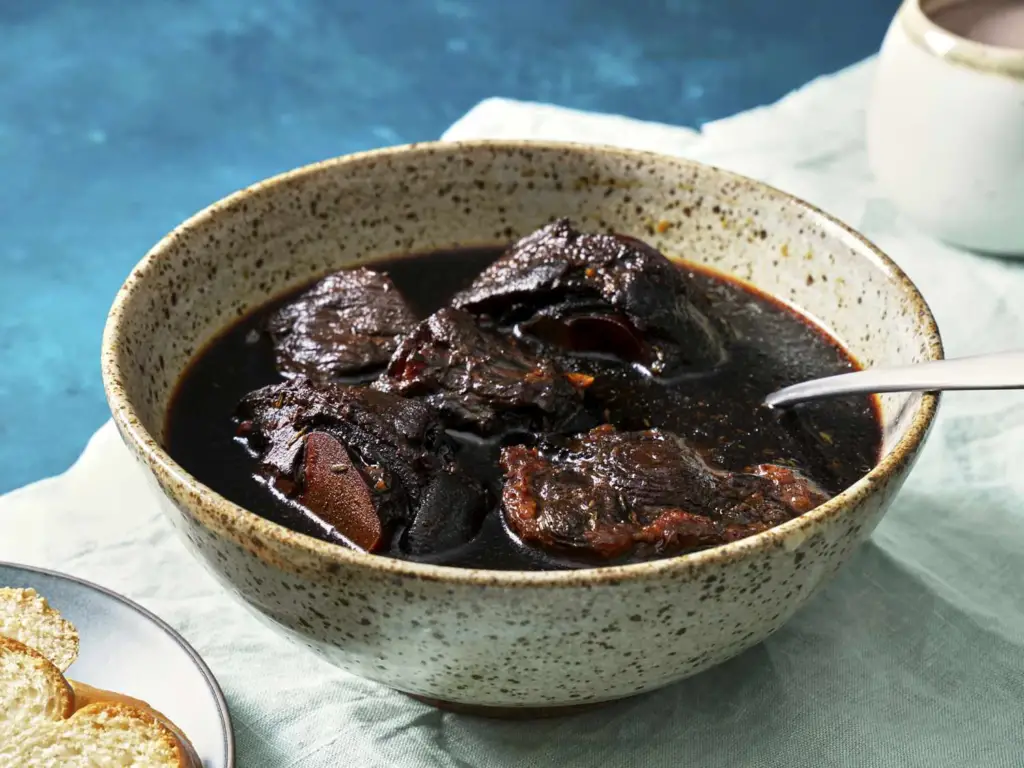
Pepperpot – Background
- Pepperpot is a dish with Amerindian roots, primarily from the indigenous Arawak and Carib peoples in Guyana.
- It has become a symbol of Guyanese cuisine and is traditionally served during Christmas and other special occasions.
- The name “pepperpot” is derived from the key ingredient, cassareep, which is made from cassava juice, and various spices that give the dish its distinct flavor.
Guyanese Cuisine – Pepperpot – Ingredients
- 2-3 pounds of mixed meats (common choices include beef, pork, and sometimes mutton or chicken)
- 4-5 cinnamon leaves or 2-3 cinnamon sticks
- 6-8 cloves
- 4-6 bay leaves
- 2-3 hot peppers (Scotch Bonnet or habanero, depending on your heat preference)
- 2-3 tablespoons vegetable oil
- 4-5 garlic cloves, minced
- 1 medium-sized onion, finely chopped
- 1 tablespoon brown sugar
- 2-3 cups cassareep (a thick, black, and molasses-like sauce made from cassava)
- Salt and black pepper to taste
- Water
Guyanese Cuisine – Pepperpot – Recipe
- Start by cleaning and cutting the meats into small, bite-sized pieces. If you’re using tough cuts of beef, you can marinate the meat in vinegar or lime juice for a couple of hours or overnight to tenderize it.
- Heat the vegetable oil in a large, heavy-bottomed pot or Dutch oven over medium-high heat. Add the minced garlic and chopped onions. Sauté them until they become fragrant and translucent.
- Add the mixed meats to the pot and brown them on all sides. This may take about 10-15 minutes.
- Once the meat is browned, add the cassareep and enough water to cover the meat. The amount of cassareep can vary depending on your taste. Start with 2 cups, and you can adjust later if needed.
- Add the cinnamon leaves or sticks, cloves, bay leaves, hot peppers, and brown sugar to the pot. These ingredients are what give pepperpot its distinctive flavor.
- Season the mixture with salt and black pepper to taste. Remember that cassareep is slightly salty, so be cautious with the salt at first.
- Reduce the heat to low, cover the pot, and let the pepperpot simmer for 2-3 hours. Check it occasionally and add more water if it gets too thick. The goal is to achieve a thick, dark, and rich sauce.
- Taste the pepperpot, and adjust the cassareep, salt, and spiciness if needed. If it’s too mild, you can add more hot peppers.
Serving Instructions
- When the meats are tender and the sauce has reached the desired consistency, remove the cinnamon sticks and bay leaves. The cinnamon leaves can be left in, but they are usually not eaten.
- Serve Guyanese Pepperpot hot with rice, cassava bread, or bread for soaking up the delicious sauce.
Guyanese Pepperpot is a labor of love, and its rich, complex flavors are well worth the effort. Enjoy this traditional dish and its unique taste of Guyana!
Guyanese Cuisine – Roti
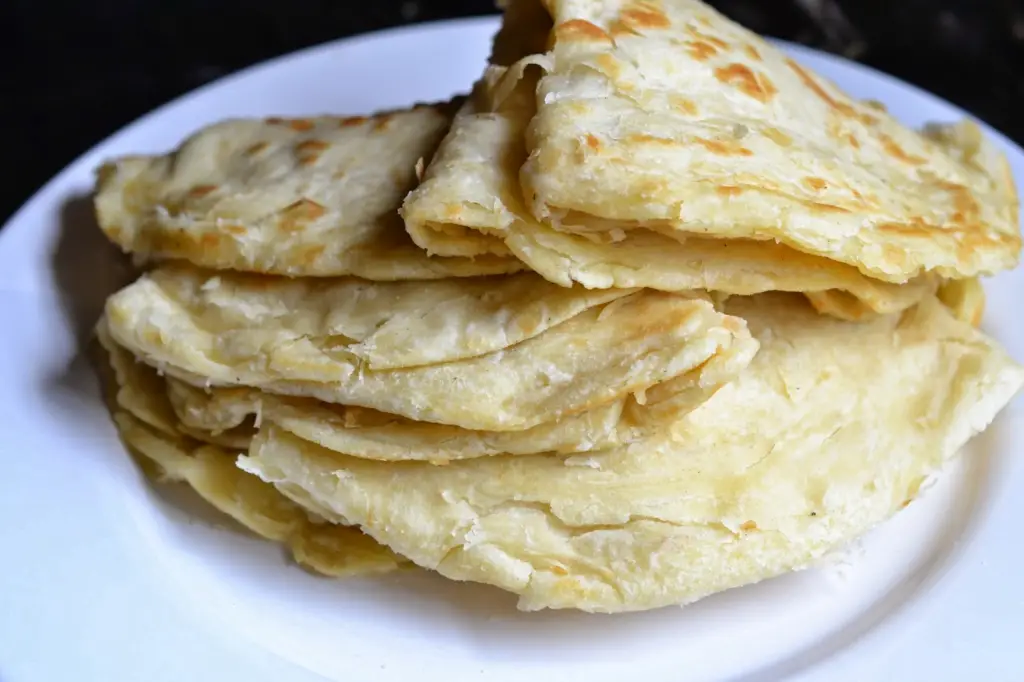
Guyanese Cuisine – Roti – Background
- Roti is a popular and versatile dish in Guyanese cuisine, with its roots in the Indian subcontinent.
- The dish was brought to Guyana by indentured laborers from India during the 19th and early 20th centuries.
- Roti is a type of unleavened flatbread that can be served with various fillings, such as curried meats, vegetables, or even dhal (lentils).
Guyanese Cuisine – Ingredients for Roti: This recipe is for the Roti bread itself.
For the Roti Dough
- 2 cups all-purpose flour
- 1 teaspoon salt
- 2 tablespoons vegetable oil or ghee
- Water (for kneading)
For Cooking
- Vegetable oil or ghee (for cooking the roti)
Ingredients for Filling (Curried Potatoes)
- 2 large potatoes, peeled and diced
- 1 medium onion, finely chopped
- 2-3 cloves of garlic, minced
- 1-2 tablespoons curry powder
- 1-2 teaspoons ground cumin
- 1-2 teaspoons ground coriander
- 1-2 teaspoons turmeric
- Salt and pepper to taste
- Vegetable oil
- Water
Guyanese Cuisine – Roti – Recipe
Preparing the Roti Dough
- In a large mixing bowl, combine the all-purpose flour and salt. Mix well.
- Add the vegetable oil (or ghee) to the dry ingredients and mix it in.
- Gradually add water to the mixture, little by little, and knead the dough until it’s smooth and elastic.
- The amount of water you need will depend on the humidity in your environment, but it’s usually around 1/2 to 3/4 cup.
- Once the dough is ready, divide it into golf ball-sized portions and roll each portion into a smooth ball.
Making the Roti
Take one of the dough balls and flatten it into a small disc with your hands. You can use a rolling pin to make it thinner, but the traditional way is to use your hands.
- Heat a griddle or a flat skillet over medium-high heat. When it’s hot, place the rolled-out dough on it.
- Cook the roti for about 1-2 minutes on each side, or until it puffs up and has brown spots.
- You can brush it with oil or ghee while cooking for added flavor.
- Repeat this process for the remaining dough balls.
Preparing the Curried Potatoes
In a separate pan, heat some vegetable oil over medium heat. Add the chopped onions and sauté until they are translucent.
- Add the minced garlic and continue to sauté for another minute.
- Add the curry powder, ground cumin, ground coriander, turmeric, salt, and pepper. Cook the spices for a couple of minutes until they release their aroma.
- Add the diced potatoes to the spice mixture and stir to coat them with the spices.
- Pour in enough water to cover the potatoes, reduce the heat, and simmer until the potatoes are tender and the curry sauce thickens (usually about 20-25 minutes).
Serving
- Place a spoonful of the curried potatoes in the center of a roti, fold the sides over, and roll it up.
- Serve your Guyanese Roti while hot. Enjoy this delicious and satisfying meal!
You can also make other fillings like curried chicken, beef, or vegetables to go with your roti, depending on your preferences. Roti is a versatile and beloved dish in Guyanese cuisine.
Guyanese Cuisine – Metemgee

Guyanese Cuisine – Metemgee Background
- Metemgee is a traditional Guyanese dish with Amerindian origins.
- The dish’s name, “Metemgee,” comes from the Arawakan word “metem,” which means “all mixed up.”
- Metemgee is a hearty one-pot meal made by combining various ingredients, such as cassava, plantains, vegetables, and meats or seafood.
- It reflects the rich cultural heritage of Guyana, which includes Amerindian, African, East Indian, and European influences.
Guyanese Cuisine – Metemgee Ingredients
Metemgee can be quite flexible with ingredients, so feel free to adapt it to your preferences. Below is a list of common ingredients, but variations exist.
For the Stew
- 1 pound mixed meats (common choices include beef, pork, and sometimes chicken or fish)
- 2-3 cloves garlic, minced
- 1 medium onion, finely chopped
- 2-3 tablespoons vegetable oil
- 1-2 tablespoons curry powder
- Salt and pepper to taste
- Water
For the Metemgee
- 1 medium-sized cassava, peeled, diced, and soaked in water
- 1-2 green plantains, peeled and sliced
- 1-2 sweet potatoes, peeled and diced
- 1-2 medium-sized eggplants, diced
- 1-2 ochroes (okra), chopped
- 1-2 bora (Chinese long beans) or string beans, chopped
- 1-2 cho-cho (chayote squash), diced
- 1-2 hot peppers (Scotch Bonnet or habanero, depending on your heat preference)
- 2-3 cloves garlic, minced
- 1-2 tablespoons vegetable oil
- Salt and black pepper to taste
- Coconut milk (1-2 cups, made from grated coconut and water)
Metemgee Recipe
Preparing the Stew
- In a large pot, heat the vegetable oil over medium-high heat.
- Add the minced garlic and chopped onions. Sauté until they become fragrant and translucent.
- Add the mixed meats to the pot and brown them on all sides.
- This may take about 10-15 minutes.
- Sprinkle curry powder over the meats and continue to cook for a few minutes to toast the spices.
- Add water to cover the meats and let it simmer until they are tender, typically for about 45 minutes to 1 hour.
Preparing the Metemgee: In a separate large pot, heat vegetable oil over medium-high heat. Add minced garlic and chopped hot peppers. Sauté for a minute or two.
- Add the soaked cassava, sliced plantains, diced sweet potatoes, and eggplants to the pot. Stir them and sauté for a few minutes.
- Pour in the coconut milk and enough water to cover the ingredients. Bring it to a simmer.
- Add the chopped ochroes, beans, cho-cho, and salt and black pepper to taste. Continue to cook until all the vegetables are tender. This usually takes about 20-30 minutes.
Bringing It All Together
- When the stewed meat is tender and the Metemgee mixture is cooked, combine the two pots by adding the stewed meat to the Metemgee mixture.
- Mix well.
- Let it simmer for a few more minutes to allow the flavors to meld.
- Taste the Metemgee and adjust the seasoning if needed, adding more salt, pepper, or hot peppers according to your preference.
- Serve Guyanese Metemgee hot. It’s a delicious and satisfying one-pot meal that reflects the diverse influences of Guyanese cuisine.
Guyanese Metemgee is a flavorful and comforting dish that brings together the rich history and culinary traditions of the country. Enjoy!
Guyanese Cuisine – Chow Mein
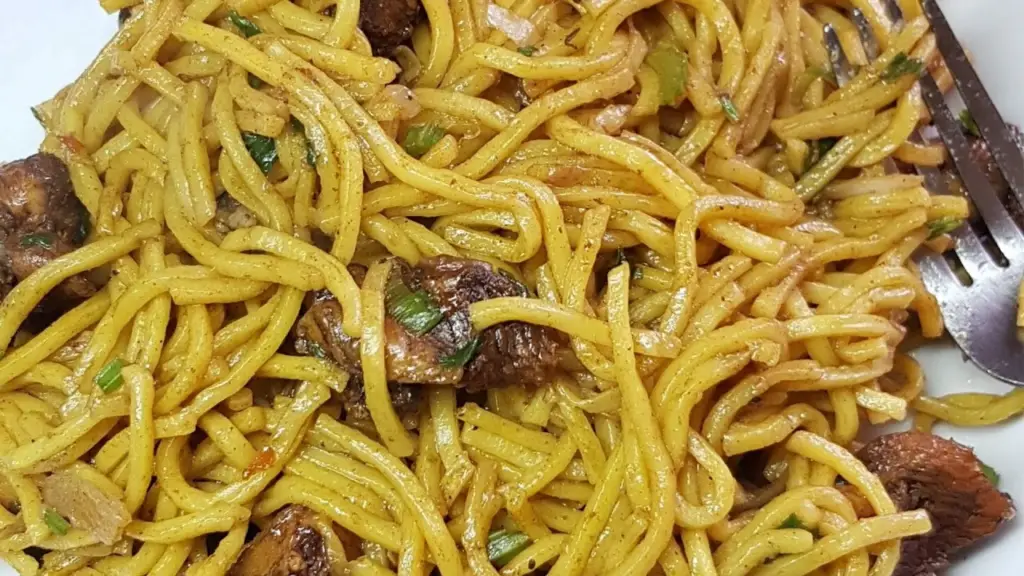
Guyanese Cuisine – Chow Mein Background
- Guyanese Chow Mein is a popular dish that combines Chinese and Guyanese culinary influences.
- Chinese immigrants brought their culinary traditions to Guyana, and these dishes became an integral part of the local cuisine.
- Guyanese Chow Mein is a stir-fried noodle dish that features a unique blend of flavors, combining Chinese and Caribbean spices.
Guyanese Cuisine – Chow Mein Ingredients
For the Noodles
- 8-10 ounces of chow mein or egg noodles (you can also use spaghetti as a substitute)
- Water for boiling
- 1-2 tablespoons vegetable oil
Sauce
- 2-3 tablespoons soy sauce
- 1-2 tablespoons oyster sauce
- 1-2 tablespoons ketchup
- 1-2 teaspoons sugar
- 1-2 teaspoons sesame oil
- 1-2 teaspoons vinegar (white or rice vinegar)
- 1-2 teaspoons hot sauce (adjust to taste)
- Salt and pepper to taste
Stir-Fry
- 2-3 tablespoons vegetable oil
- 2-3 cloves garlic, minced
- 1-2 small onions, sliced
- 1-2 bell peppers (red and green), thinly sliced
- 1-2 carrots, julienned
- 1-2 cups of cabbage, thinly sliced
- 1-2 cups of bora (Chinese long beans) or green beans, cut into 2-inch pieces
- 1-2 cups of cooked and sliced meat or tofu (common options include chicken, pork, shrimp, or tofu)
- Optional: Chinese Five Spice Powder or Guyanese “five fingers” seasoning for added flavor (adjust to taste)
Guyanese Cuisine – Chow Mein Recipe
Preparing the Noodles
- Cook the chow mein or egg noodles according to the package instructions until they are al dente.
- Drain and rinse them with cold water to stop the cooking process. Set aside.
- In a large skillet or wok, heat 1-2 tablespoons of vegetable oil over medium-high heat.
- Add the cooked noodles and stir-fry for a few minutes until they are heated through and slightly crispy.
- Remove the noodles from the pan and set them aside.
Preparing the Sauce
- In a bowl, combine soy sauce, oyster sauce, ketchup, sugar, sesame oil, vinegar, hot sauce, salt, and pepper.
- Mix well to create the sauce.
- Adjust the ingredients to your taste preference.
Stir-Frying
- In the same skillet or wok, heat 2-3 tablespoons of vegetable oil over medium-high heat.
- Add minced garlic and sliced onions, and stir-fry for a couple of minutes until they become fragrant and the onions turn translucent.
- Add the julienned carrots, sliced bell peppers, Chinese long beans, or green beans, and sliced cabbage.
- Stir-fry these vegetables until they are tender-crisp, which usually takes 5-7 minutes.
- Add the cooked meat or tofu to the vegetable mixture and stir-fry for a few more minutes until they are heated through.
- Pour the prepared sauce over the stir-fried ingredients and mix well.
- Add the cooked noodles to the skillet and toss them with the sauce and stir-fried vegetables until everything is well combined.
- If desired, sprinkle Chinese Five Spice Powder or Guyanese “five fingers” seasoning over the mixture for extra flavor.
- Taste the Guyanese Chow Mein and adjust the seasonings as needed, adding more soy sauce, hot sauce, or other ingredients according to your taste.
- Serve hot and enjoy your delicious Guyanese Chow Mein!
Guyanese Chow Mein is a flavorful and satisfying dish that represents the multicultural influences in Guyanese cuisine.
Guyanese Cuisine – Bake and Saltfish

Guyanese Cuisine – Bake and Saltfish Background
- Bake and Saltfish is a classic Guyanese dish often enjoyed for breakfast or brunch.
- The dish combines the British influence of salted codfish with the local Caribbean flavors of fried dough known as “bake.”
- It is a flavorful and filling dish that has become a staple in Guyanese cuisine.
Guyanese Cuisine – Bake and Saltfish Ingredients
For the Saltfish
- 8-10 ounces of salted codfish
- Water for soaking and boiling
- 2-3 tablespoons vegetable oil
- 1-2 cloves of garlic, minced
- 1-2 small onions, finely chopped
- 1-2 hot peppers (Scotch Bonnet or habanero, adjust to your spice preference), finely chopped
- 1-2 tomatoes, diced (optional)
- 1-2 tablespoons fresh thyme leaves (or dried thyme)
- Salt and black pepper to taste
- Lime or lemon juice for rinsing the salted codfish
For the Bake (Fried Dough)
- 2 cups all-purpose flour
- 2 teaspoons baking powder
- 1/2 teaspoon salt
- Water (about 3/4 to 1 cup)
- Vegetable oil for frying
Guyanese Cuisine – Bake and Saltfish Recipe
Preparing the Saltfish
- Start by desalting the salted codfish.
- Rinse the salted codfish in cold water to remove excess salt, then place it in a bowl and cover it with water.
- Allow it to soak for at least 4-6 hours or overnight.
- Change the water a few times during the soaking period to remove more salt.
- After desalting, drain and rinse the codfish thoroughly.
- Shred it into small pieces or flakes.
- In a large skillet, heat 2-3 tablespoons of vegetable oil over medium-high heat.
- Add the minced garlic and chopped onions, and sauté until they become fragrant and translucent.
- Add the shredded codfish, hot peppers, diced tomatoes (if using), and fresh thyme leaves (or dried thyme).
- Stir-fry these ingredients for about 5-7 minutes until everything is well combined and the codfish is cooked through.
- Taste the saltfish and adjust the seasoning with salt, pepper, and lime or lemon juice if needed.
- Keep it warm while you prepare the bake.
Preparing the Bake (Fried Dough)
- In a large mixing bowl, combine the all-purpose flour, baking powder, and salt.
- Gradually add water to the dry ingredients, little by little, and knead the mixture into a soft, smooth dough.
- You should aim for a consistency similar to bread dough.
- Divide the dough into small, golf ball-sized portions and roll them into smooth balls.
- Heat vegetable oil in a deep skillet or frying pan over medium-high heat. The oil should be hot, but not smoking.
- Flatten each dough ball into a small disc, about 1/4-inch thick.
- You can use a rolling pin or your hands to do this.
- Carefully place the flattened dough into the hot oil and fry until they puff up and turn golden brown on both sides.
- This usually takes about 2-3 minutes per side.
- Remove the fried bake and drain on paper towels to remove excess oil.
Serving
Serve the freshly fried bake with the prepared saltfish. The bake is often used to scoop up the saltfish and enjoy it as a sandwich or on the side.
Bake and Saltfish is a flavorful and filling Guyanese breakfast or brunch dish that combines the salty richness of saltfish with the warm, fluffy goodness of fried dough. Enjoy!
Conclusion
As we come to the end of our journey through the flavors of Guyanan cuisine, we hope that we’ve inspired your taste buds to venture into this vibrant and diverse culinary world. The fusion of African, Indian, Chinese, and Indigenous traditions, combined with the unique ingredients and techniques of the Guyanese people, make for an unforgettable dining experience.
So, whether you visit a Guyanese restaurant or simply try a Guyanese-inspired dish at home, we encourage you to spread the word about the incredible flavors of Guyanan cuisine. Let’s celebrate and share the unique and unforgettable tastes of Guyana with the world!
FAQ’s
What is Guyanan Cuisine?
Guyanan Cuisine refers to the culinary traditions and dishes from the South American country of Guyana. It is a delightful fusion of flavors influenced by the country’s multicultural heritage, incorporating elements from African, Indian, Chinese, and Indigenous traditions.
What are some traditional Guyanese dishes?
Some traditional Guyanese dishes include mouthwatering curries, aromatic stews, hearty roti, delicious seafood, and more. Guyanese cuisine offers a wide variety of flavors and ingredients that will leave you craving for more.
Guyana National Food
Guyana’s national food is pepperpot, a rich and spicy meat stew. This traditional dish is made using ingredients like beef or pork, cassareep (a sauce made from cassava root), and a variety of spices. Pepperpot is often served with rice and is a staple in Guyanese cuisine.
Can I cook Guyanese dishes at home?
Absolutely! You can bring the flavors of Guyana into your own kitchen with authentic Guyanese recipes. We provide step-by-step instructions and tips on how to recreate traditional Guyanese dishes, allowing you to experience the taste of Guyanese cuisine in the comfort of your own home.
How does Guyanese cuisine reflect the country’s cultural traditions?
Guyanese cuisine reflects the history, traditions, and values of the Guyanese people. From festive celebrations to everyday meals, each dish carries cultural significance and tells a story. Exploring Guyanese culinary traditions provides insight into the rich heritage of the country.
Where can I find Guyanese cuisine outside of Guyana?
Guyanese cuisine has made its way around the world, particularly in Guyanese communities in North America and the Caribbean. You can find restaurants, food trucks, and home cooks who have embraced the deliciousness of Guyanese cuisine, allowing you to savor its flavors even if you’re not in Guyana.
What makes Guyanan Cuisine unique?
Guyanan Cuisine is unique due to its fusion of flavors and diverse ingredients. Influenced by various cultural traditions, it offers a journey for the senses, from fiery spices to subtle sweetness. Each dish showcases the incredible diversity and vibrancy of Guyanese culinary traditions.
Why should I try Guyanan Cuisine?
Trying Guyanan Cuisine is an opportunity to experience unforgettable tastes and discover a whole new world of flavors. Whether you are a food enthusiast or simply looking to try something new, Guyanan Cuisine offers a culinary journey that is sure to delight your taste buds.
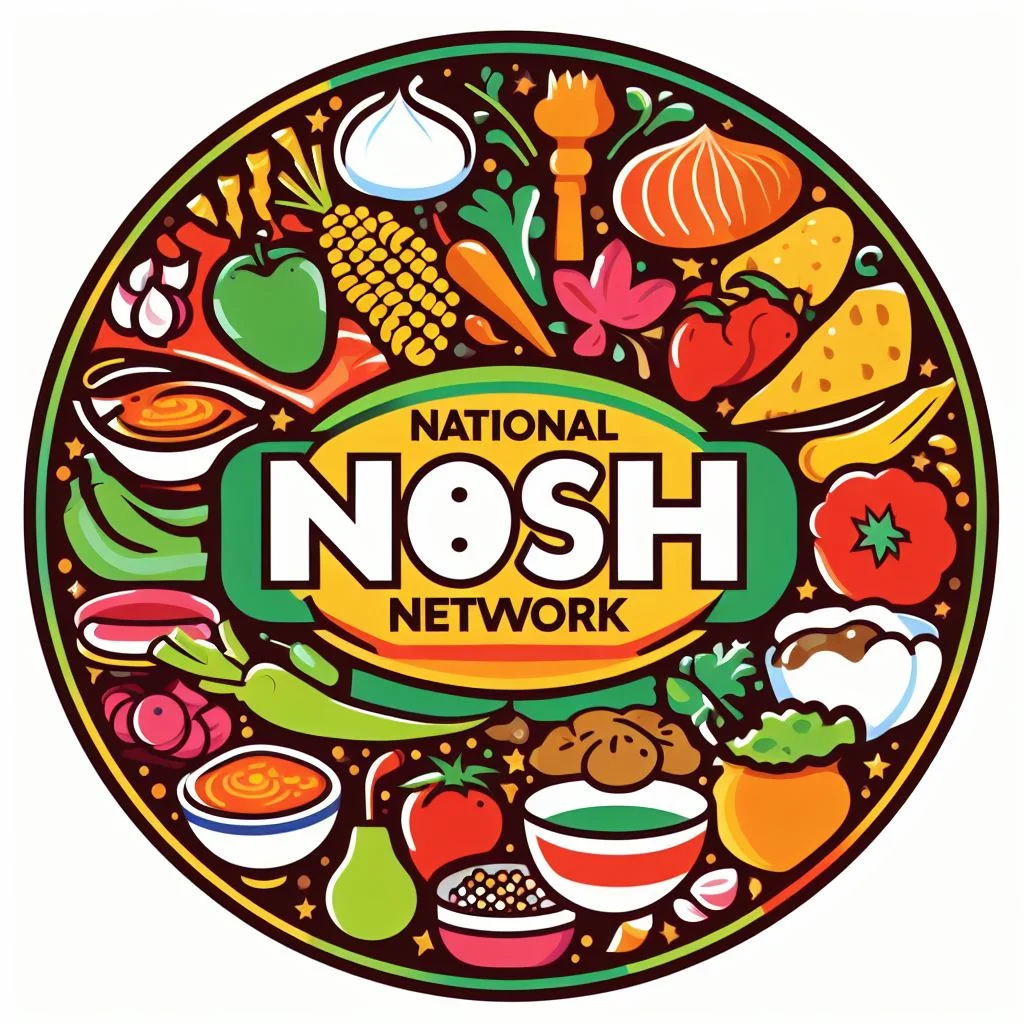
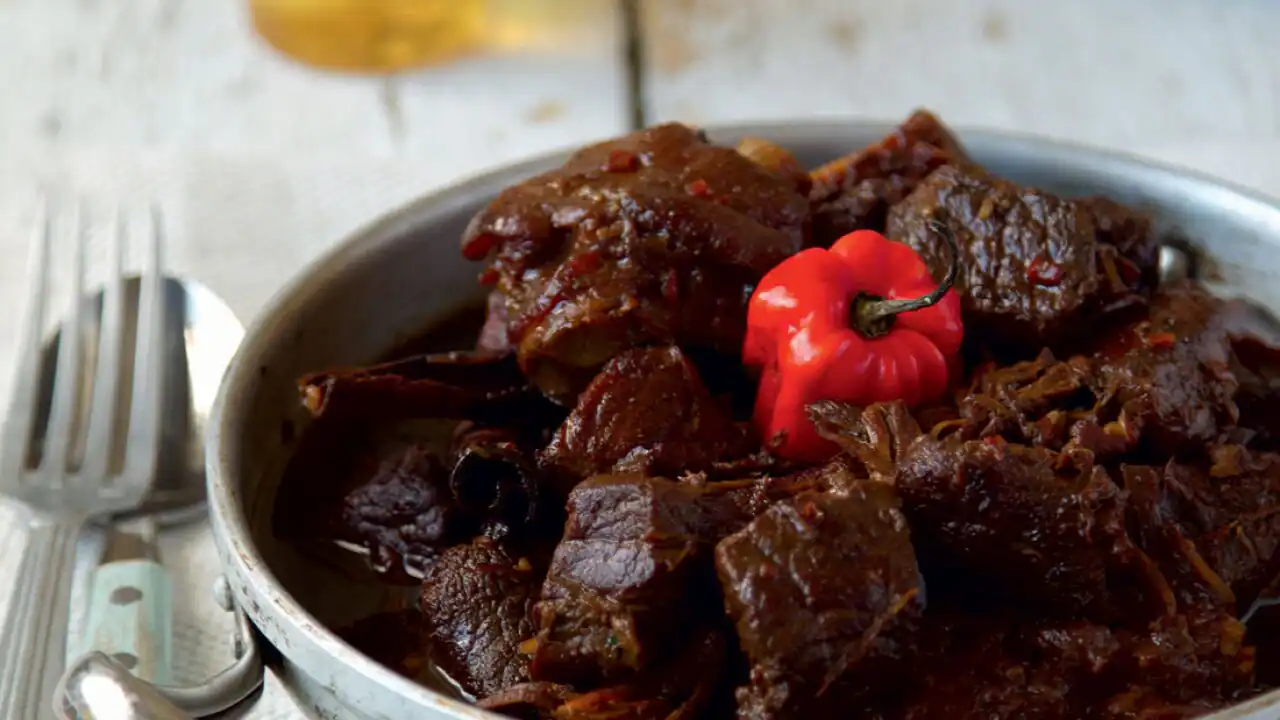
Your articles are extremely helpful to me. Please provide more information!
HI there